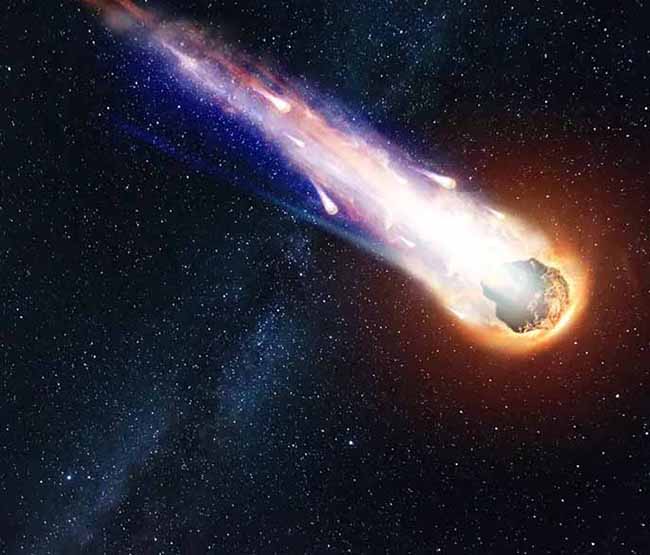
A comet is basically a ball of ice and dust that looks like a star with a tail.
Some comets do not have tails, looking like hazy, round spots of light.

A comet is basically a ball of ice and dust that looks like a star with a tail.
Some comets do not have tails, looking like hazy, round spots of light.
�A comet is a small body in the solar system that orbits the Sun and (at least occasionally) exhibits a coma (or atmosphere) and/or a tail - both primarily from the effects of solar radiation upon the comet's nucleus, which itself is a minor body composed of rock, dust, and ice. Comets' orbits are constantly changing: their origins are in the outer solar system, and they have a propensity to be highly affected (or perturbed) by relatively close approaches to the major planets.
Some comets are moved into sun grazing orbits that destroy the comets when they near the Sun, while others are thrown out of the solar system forever. A new comet may be discovered photographically using a wide-field telescope or visually with binoculars. However, even without access to optical equipment, it is still possible for the amateur astronomer to discover a sun grazing comet online.
Most comets are believed to originate in a cloud (the Oort cloud) at large distances from the Sun consisting of debris left over from the condensation of the solar nebula; the outer edges of such nebulae are cool enough that water exists in a solid (rather than gaseous) state. Asteroids originate via a different process, but very old comets which have lost all their volatile materials may come to resemble asteroids.
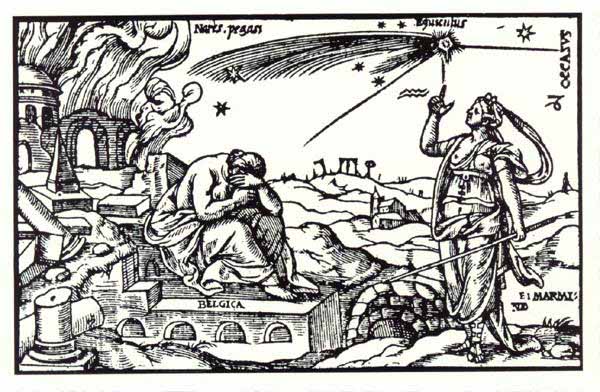
Historically, comets were thought to be unlucky, harbingers of destruction by anthropomorphic gods, or aliens, against humans. People are programmed to fear the unknown, but through scientific discovery, as with everything else along the way to enlightenment, there is always a physical explanation.
'Dark Comets' Come in Different Varieties, And It Could Have Implications For Life on Earth Science Alert - December 11, 2024

Dark comets look like asteroids, but behave like a comet. The identity of these objects was unveiled in 2023, with first one dark comet, and then six more. Now, an international team of astronomers has unmasked another seven, doubling the number and bringing the total known to 14. This new data reveals that not even all dark comets are the same: there are at least two different kinds. The discovery of multiple kinds of dark comets could tell us more about how Earth was made habitable for life.
Astronomers discover more dark comets - a celestial object that looks like an asteroid but moves through space like a comet PhysOrg - December 9, 2024

There are two kinds of dark comets: outer dark comets and inner dark comets
Study highlights role of dark comets and active asteroids in delivering water to Earth NDTV - July 17, 2024
There is a new class of space objects known as "dark comets" that astronomers have discovered that may provide information on the origins of Earth's water. These enigmatic objects could account for as much as 60% of all near-Earth objects; they seem to be asteroids with ice hidden beneath their surface. Dark comets are not blurry like regular comets' coma and tail. On the other hand, they show an inexplicable acceleration, suggesting the existence of unobserved emissions, most likely due to sublimating ice. Researchers believe these dark comets originate from the asteroid belt between Mars and Jupiter. Through computer simulations, they were able to mimic the dark comets' orbits and trace them back to the inner part of the asteroid belt. This finding supports the long-held theory that icy materials are common within the asteroid belt. The discovery of dark comets strengthens the possibility that icy objects delivered water to Earth early in its formation. This idea is further bolstered by the existence of "active asteroids"-objects t that display comet-like behavior within the asteroid belt. While the exact connection between dark comets and active asteroids remains unclear, both types of objects could be key players in the story of Earth's water. Future studies will likely shed more light on these intriguing celestial bodies.
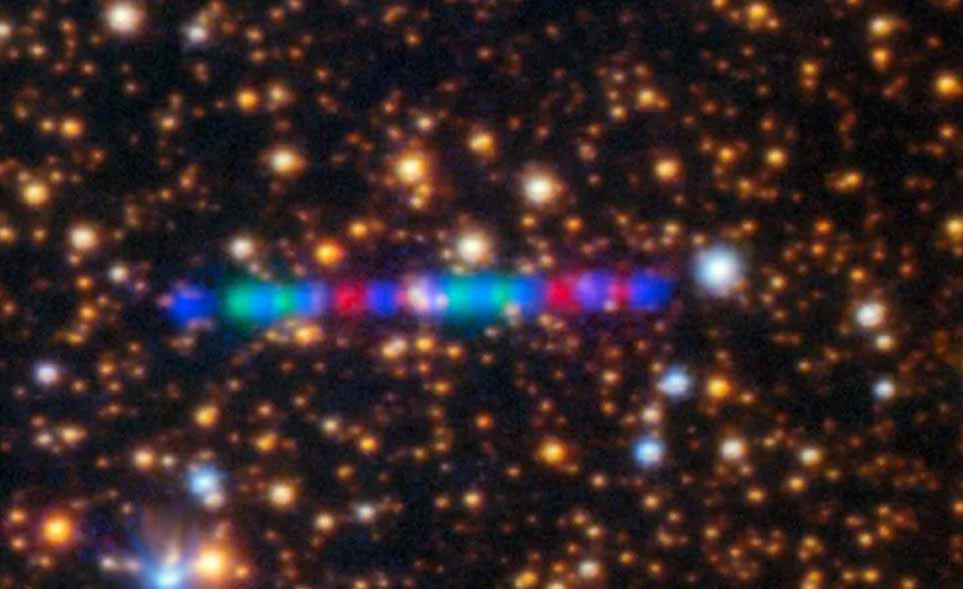
It is just a comet not a UFO (UAP)

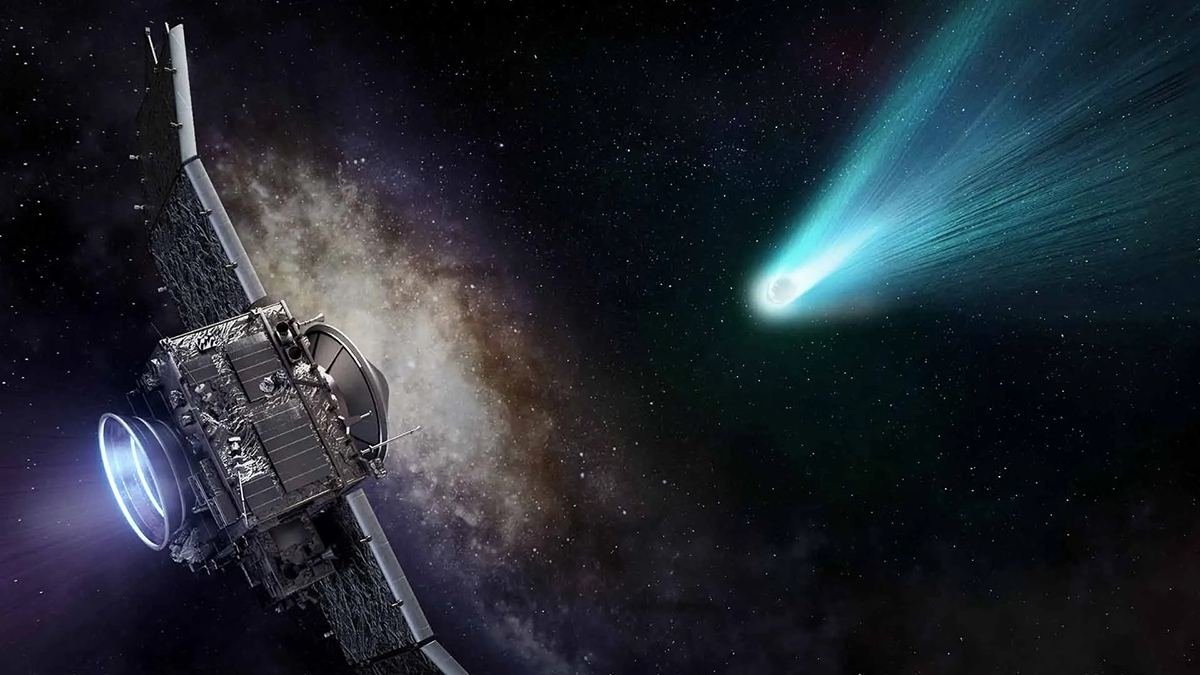
3I/ATLAS is an interstellar comet discovered by the Asteroid Terrestrial-impact Last Alert System (ATLAS) station at Ro Hurtado, Chile on 1 July 2025. It will not come closer than 1.8 AU (270 million km; 170 million mi) from Earth, so it poses no threat. It is the third interstellar object confirmed passing through the Solar System, after 11/'Oumuamua discovered in October 2017) and 2I/Borisov (discovered in August 2019), hence the prefix "3I". Read more ...
Interstellar comet 3I/ATLAS makes closest pass of Earth. Where's it heading next? Live Science - December 20, 2025
Researchers have identified a distinctive ultraviolet signature of water in the interstellar comet 3I/ATLAS SciTech Daily - December 18, 2025
Interstellar comet 3I/ATLAS reveals signs of metal, carbon, and possible cryovolcanism Watchers - December 7, 2025
3I/ATLAS Isn't an Alien Death Probe, But It Is Wildly Unusual Science Alert - November 13, 2025
Where did the interstellar comet 3I/ATLAS come from? PhysOrg - September 12, 2025
What 3I/ATLAS tells us about other solar systems PhysOrg - September 11, 2025
3I/ATLAS is 7 miles wide - the largest interstellar object ever seen - new photos from Rubin Observatory reveal Live Science - July 24, 2025
Interstellar comet 3I/ATLAS transforms into a giant 'cosmic rainbow' in trippy new telescope image Science Alert - July 17, 2025
It's not an alien probe.
New paper by Abraham (Avi) Loeb the Baird Professor of Science and Institute director at Harvard University suggests comet 3I/ATLAS might be alien tech Watchers - July 23, 2025
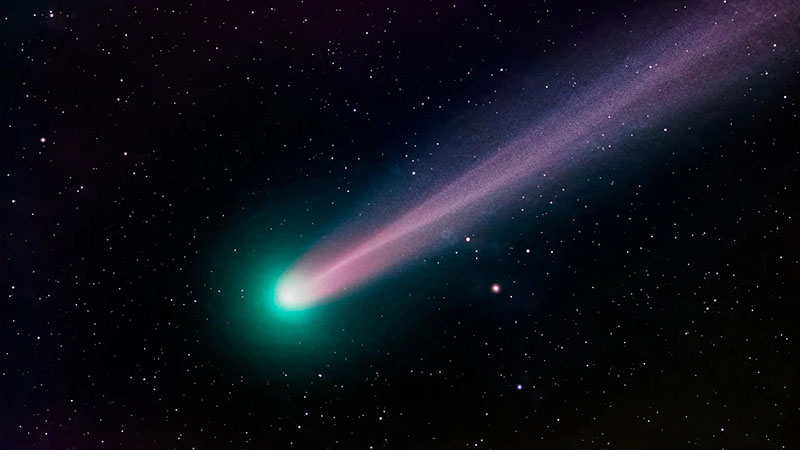
A rare comet, a jewel in the night with a dashing bright green nucleus, is about to grace the skies for what might be the first time since the Stone Age (50,000 years ago give or take). C/2022 E3 (ZTF) is a long period comet that was discovered by the Zwicky Transient Facility on 2 March 2022. The comet reached its perihelion on January 12, 2023, at a distance of 1.11 AU (166 million km) and the closest approach to Earth will be on February 1, 2023, at a distance of 0.28 AU (42 million km). The comet is expected to get brighter than magnitude 6 and thus become visible with the naked eye.
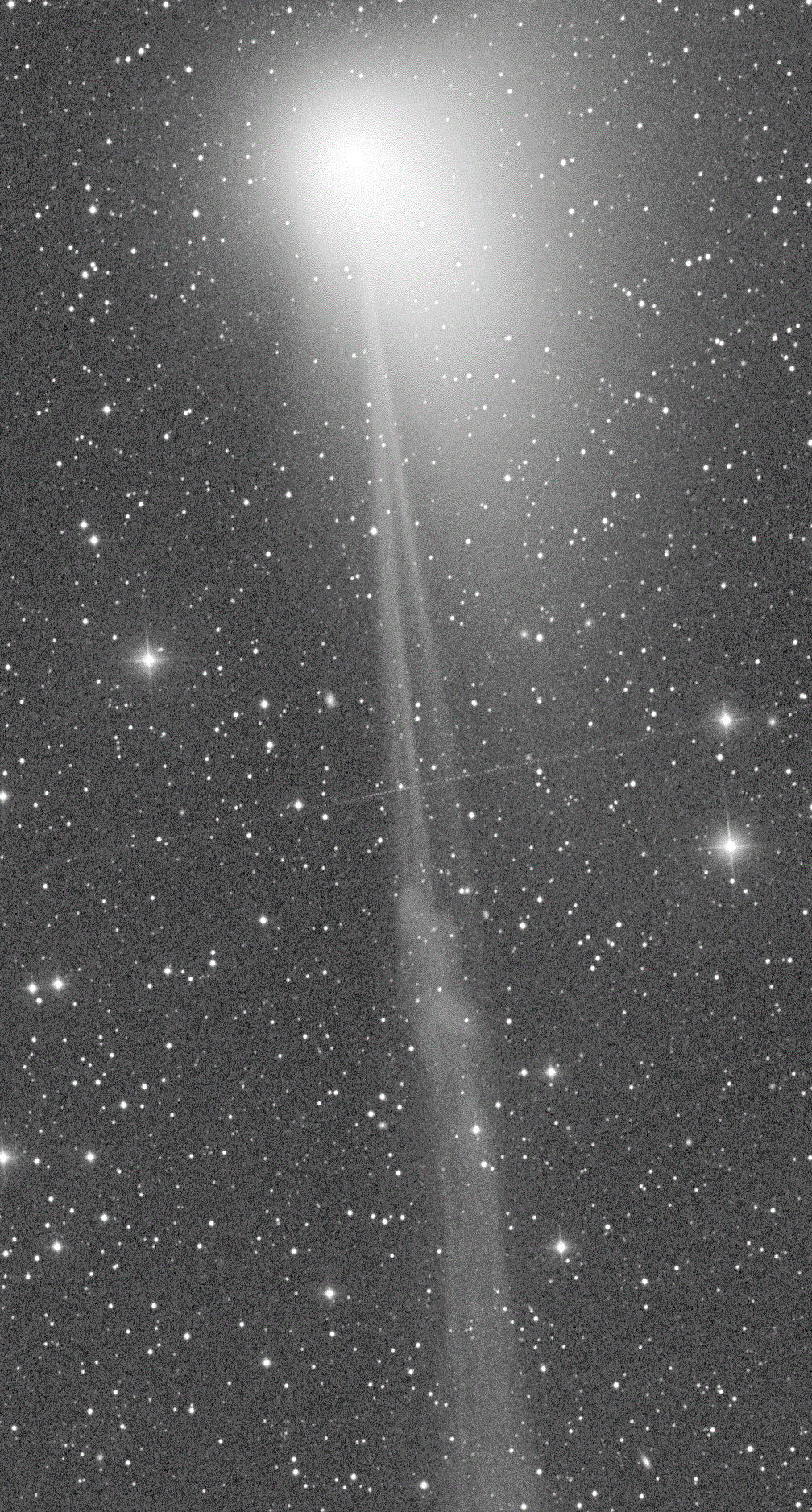
Stunning images capture the moment a green comet's tail is blasted away by the sun Live Science - January 23, 2023
An amateur astronomer witnessed the moment that the green comet C/2022 E3 had part of its tail blasted away by a coronal mass ejection. A rare green comet passing through our solar system for the first time in 50,000 years received a warm welcome from the sun this week... perhaps too warm. Images captured by Michael Jger an amateur astronomer based in Austria, reveal a huge spike of gas disconnecting from the comet's tail and drifting off on the solar wind. This impromptu tail reduction was almost certainly caused by an explosion of super-charged solar particles called a coronal mass ejection (CME),
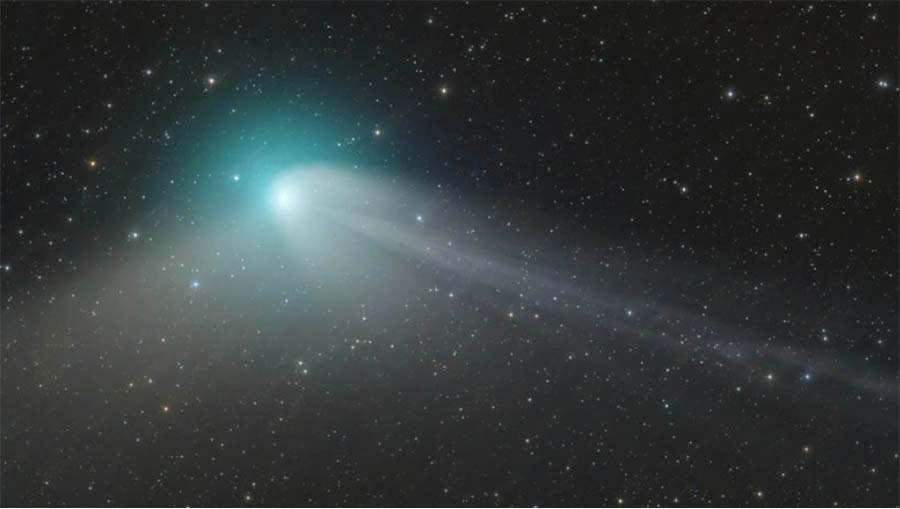
Newly discovered green comet comes close to Earth BBC - February 1, 2023
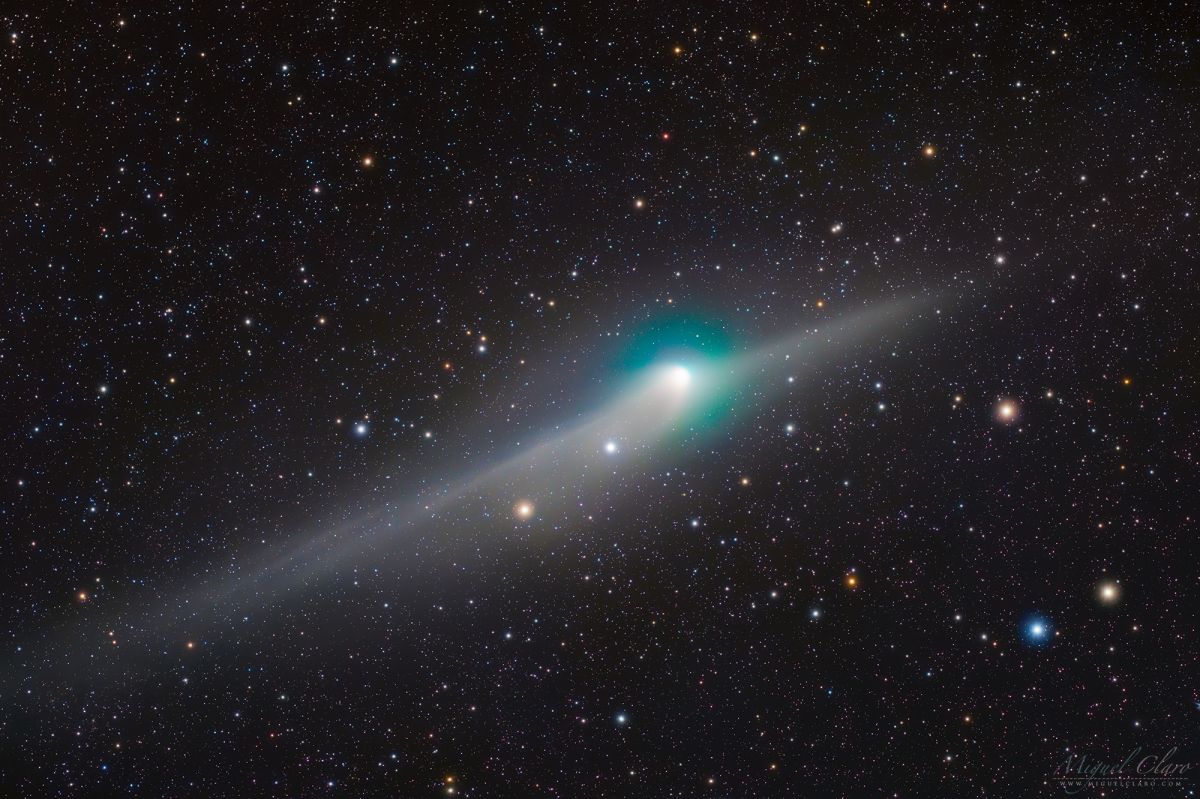
Green comet flaunts its tail in dazzling deep space photo
BBC - February 1, 2023
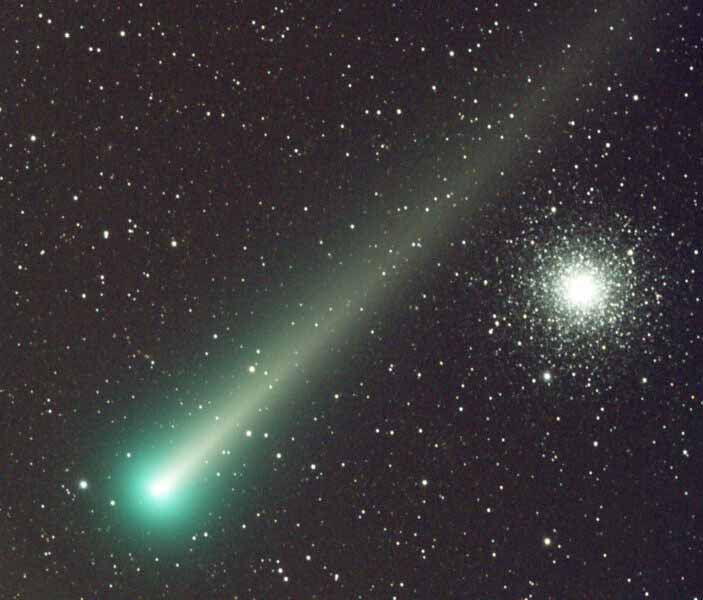
C/2021 A1 (Leonard) Wikipedia
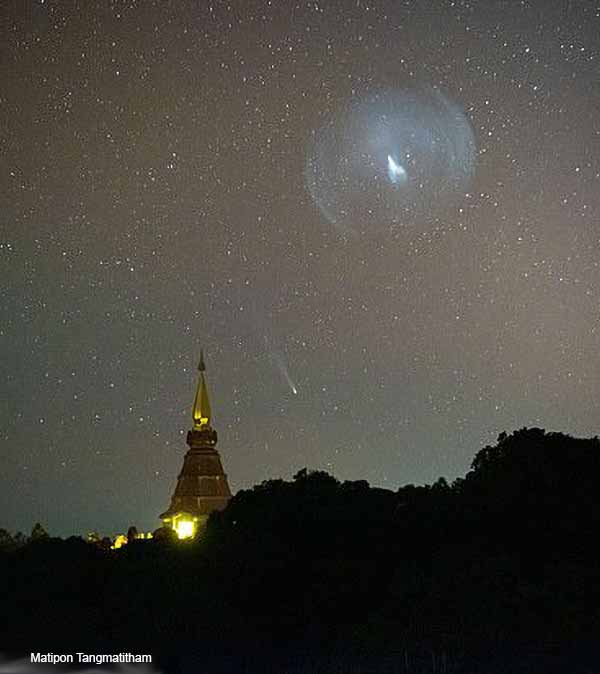
NASA shared a stunning photo of Comet Leonard soaring behind
the plume from NASA's James Webb Space Telescope launch 12/25/2021.
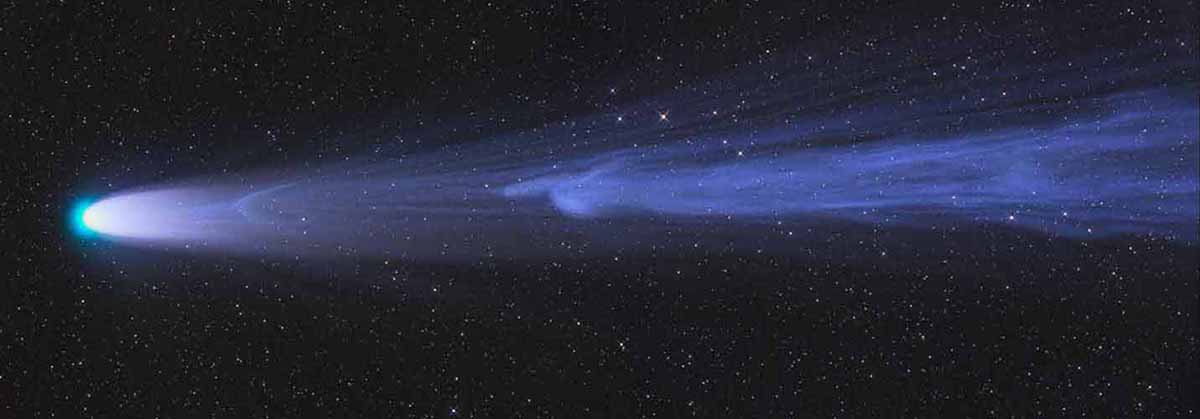
Spaceweather.com December 26, 2021 - Something unusual happened to Comet Leonard's tail. It's being disconnected. About halfway down the picture a dense plume of gas appears. It looks like a 'tail within a tail.' This could be a disconnection event: A piece of the tail has been pinched off and is being carried away by the solar wind. What could cause such an event? Space weather. CMEs or even ordinary solar wind streams hitting comets can cause magnetic reconnection in the comets' ionized tails, sometimes ripping them off entirely. NASA's STEREO-A spacecraft watched this happen to Comet Encke in April 2007. Alternately, this could could be a knot of debris from a recent outburst in the comet's core. Comet Leonard has flared in brightness 3 times since Dec. 15th--a sign of possible fragmentation. Much of the structure in the tail is doubtless an imprint of Comet Leonard's rapid-fire instabilities. Whatever is happening, get ready for more. Comet Leonard is approaching the sun for a 0.61 AU close approach on Jan. 3rd. Increasing heat and proximity to solar storms could spark new outbursts and disconnection events.
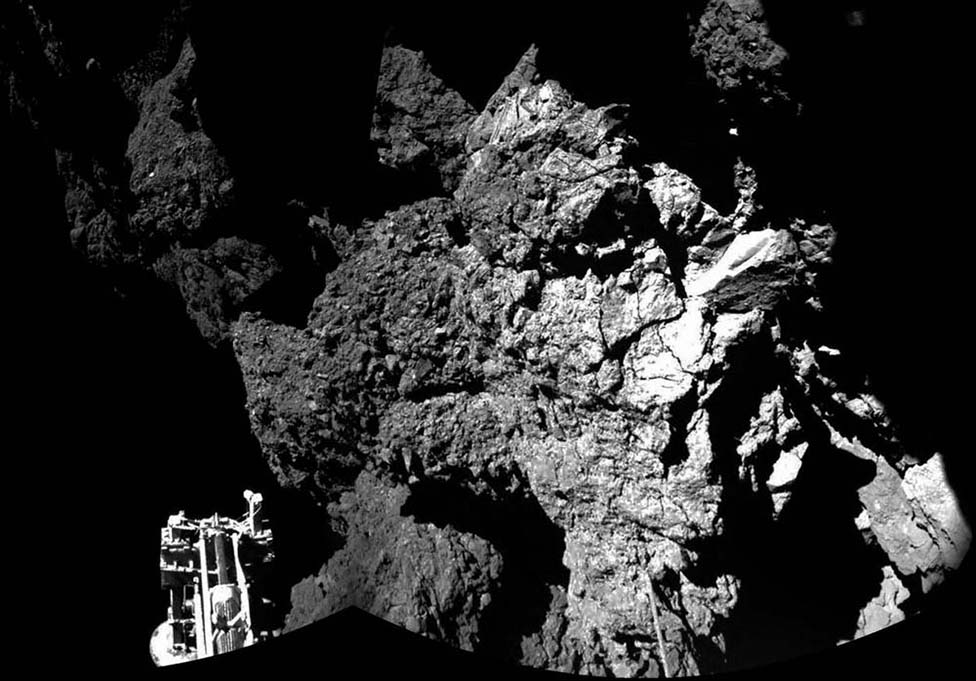
Rosetta's 'rubber ducky' comet has ultraviolet auroras Live Science -September 26, 2020
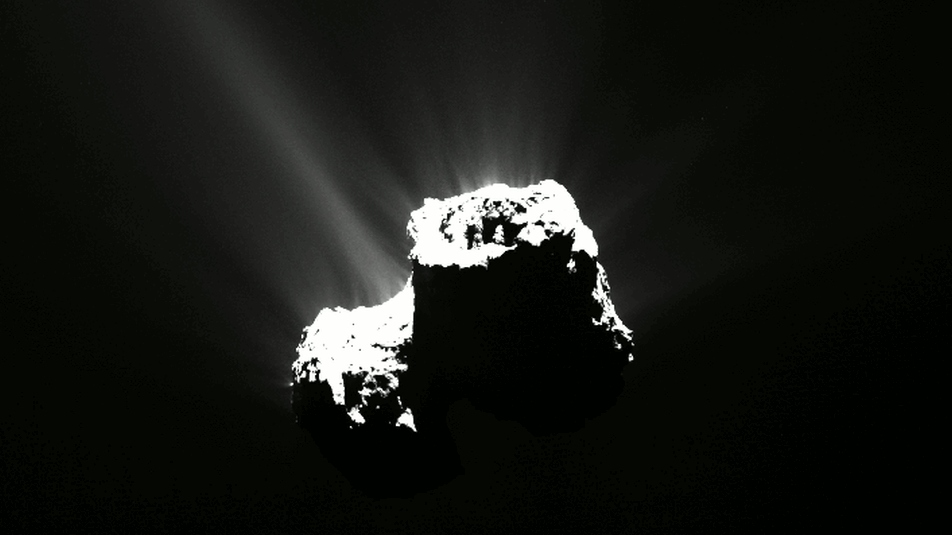
While looking at data from Rosetta, researchers found evidence of ultraviolet auroras at Comet 67P/Churyumov-Gerasimenko, which the probe studied up close for nearly two years before the mission ended in 2016.
Comet discovered to have its own northern lights Science Alert -September 21, 2020
Comet 67P/Churyumov-Gerasimenko has its own far-ultraviolet aurora, data reveal. It is the first time such electromagnetic emissions in the far-ultraviolet have been documented on a celestial object other than a planet or moon.
Rosetta mission ends in comet collision BBC - September 30, 2016
Europe's Rosetta probe has ended its mission to Comet 67P by crash-landing on to the icy object's surface. Mission control in Darmstadt, Germany, was able to confirm the impact had occurred when radio contact to the aging spacecraft was lost abruptly. The assumption is that the probe would have been damaged beyond use.
Farewell Philae: Earth severs link with silent comet probe PhysOrg - July 27, 2016
Earth bid a final farewell to robot lab Philae on Wednesday, severing communications after a year-long silence from the pioneering probe hurtling through space on a comet. Philae sent home reams of data garnered from sniffing, tasting and prodding its new alien home hundreds of millions of kilometres (miles) from Earth.
First picture from comet 67P
Rosetta rendezvouzed with comet 67P/Churyumov-Gerasimenko August 6, 2014 and entered orbit on September 10, 2014. Rosetta's lander, Philae, landed on its surface on November 12, 2014, becoming the first spacecraft to land on a comet nucleus.
Farewell, Philae: Hunt for Rosetta's Lost Lander Ends Discovery - February 13, 2016
Scientists were excited when they picked up Philae's signal last summer, but control teams were never able to maintain communications long enough to put Philae back to work, most likely due to a failure of the lander's transmitter, ESA said. The last contact from Philae was on June 13.
Perihelion Approaches NASA - August 15, 2015
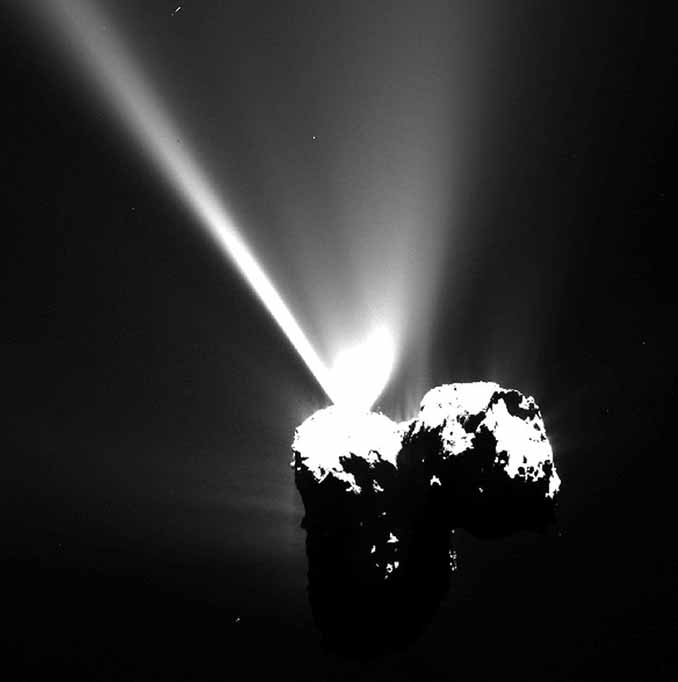
This dramatic outburst from the nucleus of Comet 67P/Churyumov-Gerasimenko occured on August 12, just hours before perihelion, its closest approach to the Sun. Completing an orbit of the Sun once every 6.45 years, perihelion distance for this periodic comet is about 1.3 astronomical units (AU), still outside the orbit of planet Earth (at 1 AU). The stark image of the 4 kilometer wide, double-lobed nucleus in bright sunlight and dark shadows was taken by the Rosetta spacecraft's science camera about 325 kilometers away. Too close to see the comet's growing tail, Rosetta maintains its ringside seat to watch the nucleus warm and become more active in coming weeks, as primordial ices sublimating from the surface produce jets of gas and dust. Of course, dust from the nucleus of periodic comet Swift-Tuttle, whose last perihelion passage was in 1992 at a distance of 0.96 AU, fell to Earth just this week.
Philae Probe Finds Evidence That Comets Can Be Cosmic Labs Epoch Times - July 31, 2015
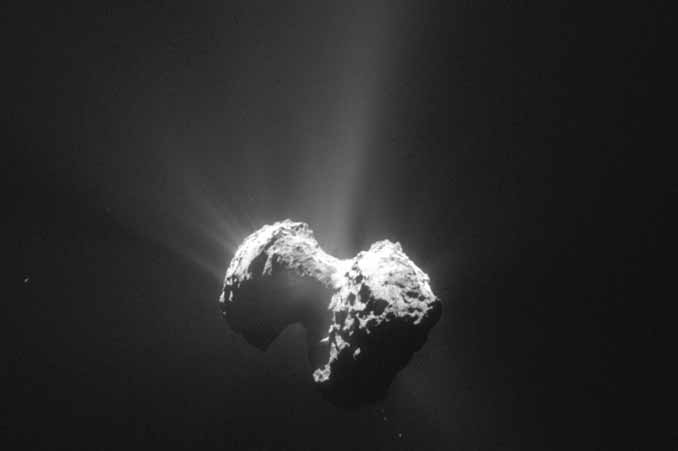
Comets are loaded with all the raw materials like water, CO2, methane, ammonia, needed to assemble more complex organic molecules, perhaps sparked by UV-photons from the Sun or cosmic rays, or in the shock that occurs when a comet hits the surface of a planet like the young Earth.
Philae comet lander wakes up BBC - June 14, 2015
Philae, the first spacecraft to land on a comet, was dropped on to the surface of Comet 67P by its mothership, Rosetta, last November. It worked for 60 hours before its solar-powered battery ran flat.
Rosetta Pours Cold Water on Cometary Origins of Earth's Oceans Scientific American - December 10, 2014
In the Enuma Elish, a Babylonian epic that recounts the creation of the world, the heavens and the Earth emerge from a primordial abyss of brackish water. According to the biblical book of Genesis, water existed before land, life, and even light itself. Our ancient ancestors realized, just as we do today, that water is fundamental to life. But even though they could conceive creation stories for the Earth, moon, and stars, many cultures at the dawn of recorded history seemed baffled by the origin of our planet's water. Thousands of years later, the genesis of Earth's oceans remains one of the key missing pieces in our modern creation stories.
Mystery of where Earth's water came from deepens PhysOrg - December 10, 2014
The mystery of where Earth's water came from got murkier Wednesday when some astronomers essentially eliminated one of the chief suspects: comets. Over the past few months, the European Space Agency's Rosetta space probe closely examined the type of comet that some scientists theorized could have brought water to our planet 4 billion years ago. It found water, but the wrong kind.
Comet landing: Organic molecules detected by Philae BBC - November 19, 2014
The Philae lander has detected organic molecules on the surface of its comet, scientists have confirmed. Carbon-containing "organics" are the basis of life on Earth and may give clues to chemical ingredients delivered to our planet early in its history. The compounds were picked up by a German-built instrument designed to "sniff" the comet's thin atmosphere. Other analyses suggest the comet's surface is largely water-ice covered with a thin dust layer.
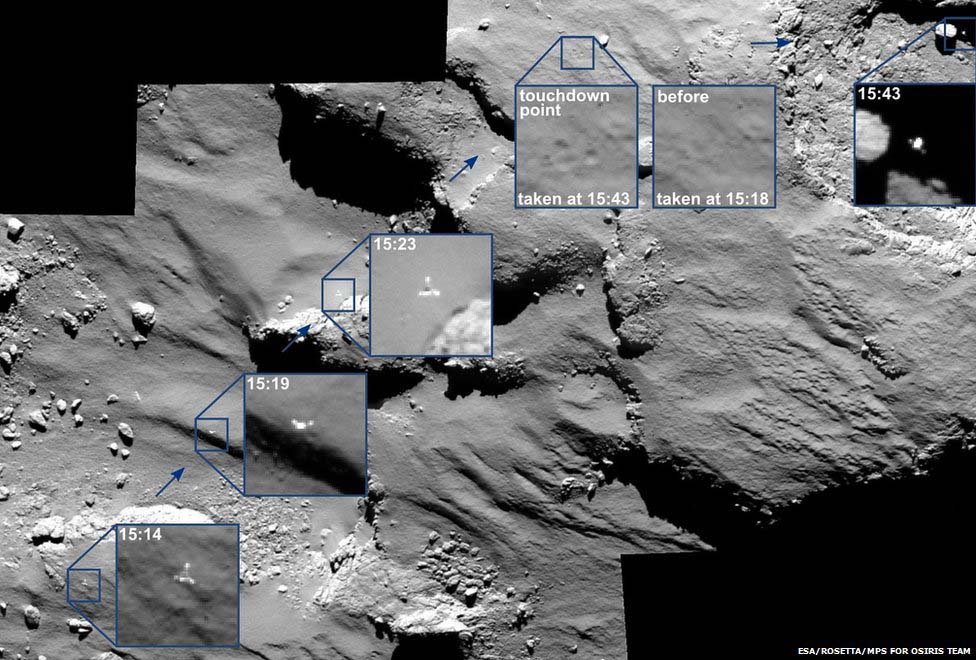
Camera sees Philae's bouncy landing BBC - November 18, 2014
Comet Lovejoy shows asymmetric behavior at perihelion PhysOrg - July 27, 2016
Indian astronomers have recently conducted spectrographic observations of long-period Comet Lovejoy to study its gas emission. They found that this comet showcases an asymmetric behavior at perihelion and an increase in the activity during the post-perihelion phase. The findings were detailed in a paper published July 22 on the arXiv pre-print server.
In unexpected discovery, comet contains alcohol, sugar PhysOrg - October 23, 2015
Comet Lovejoy lived up to its name by releasing large amounts of alcohol as well as a type of sugar into space, according to new observations by an international team. The discovery marks the first time ethyl alcohol, the same type in alcoholic beverages, has been observed in a comet. The finding adds to the evidence that comets could have been a source of the complex organic molecules necessary for the emergence of life.
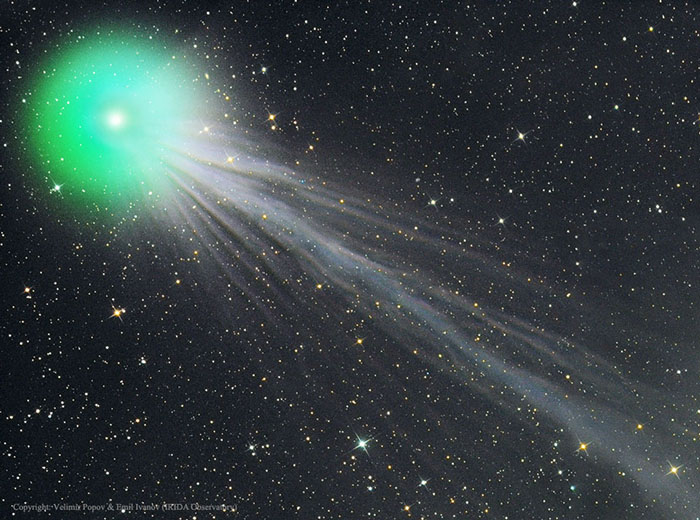
The Complex Ion Tail of Comet Lovejoy APOD - January 20, 2015
What causes the structure in Comet Lovejoy's tail? Comet C/2014 Q2 (Lovejoy), which is currently at naked-eye brightness and near its brightest, has been showing an exquisitely detailed ion tail. As the name implies, the ion tail is made of ionized gas -- gas energized by ultraviolet light from the Sun and pushed outward by the solar wind. The solar wind is quite structured and sculpted by the Sun's complex and ever changing magnetic field. The effect of the variable solar wind combined with different gas jets venting from the comet's nucleus accounts for the tail's complex structure.
Following the wind, structure in Comet Lovejoy's tail can be seen to move outward from the Sun even alter its wavy appearance over time. The blue color of the ion tail is dominated by recombining carbon monoxide molecules, while the green color of the coma surrounding the head of the comet is created mostly by a slight amount of recombining diatomic carbon molecules. The featured three-panel mosaic image was taken nine days ago from the IRIDA Observatory in Bulgaria. Comet Lovejoy made it closest pass to the Earth two weeks ago and will be at its closest to the Sun in about ten days. After that, the comet will fade as it heads back into the outer Solar System, to return only in about 8,000 years.
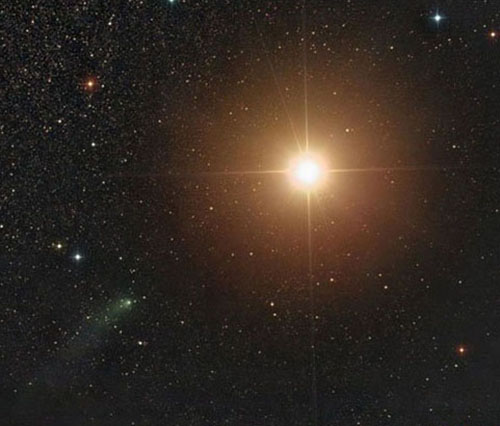
Comet Siding Spring skims past Mars BBC - October 19, 2014
A recently discovered comet has whizzed past Mars, giving scientists a unique chance to study an object from the farthest reaches of the Solar System. The comet, known as Siding Spring, raced past Mars at 56km per second (125,000mph), missing it by 139,500 km. Rovers on the Martian surface and satellites were primed to catch the event on their cameras and instruments.
Comet Siding Spring Passes Mars APOD - October 20, 2014
Yesterday, a comet passed very close to Mars. In fact, Comet C/2013 A1 (Siding Spring) passed closer to the red planet than any comet has ever passed to Earth in recorded history.
C/2013 A1 (Siding Spring) Wikipedia
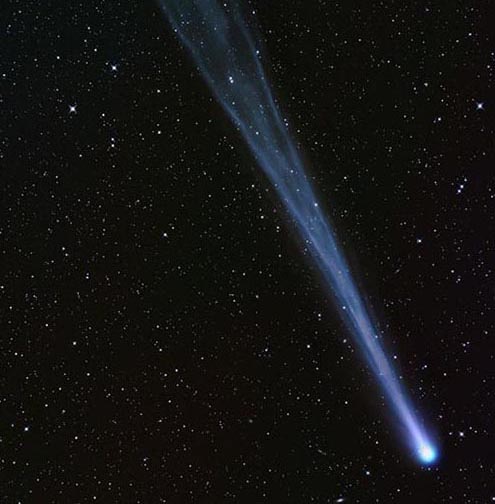
Comet ISON
Wikipedia
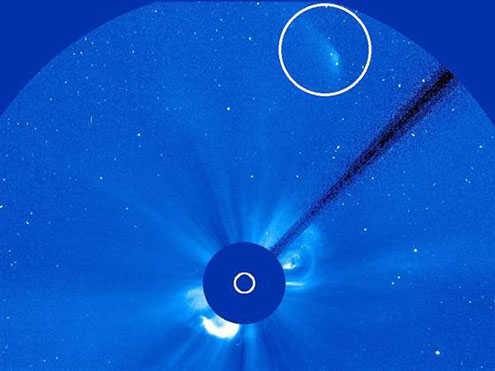
Comet ISON's leftovers fade away, right before a satellite's eyes
The white circle highlights Comet ISON's remnants toward the edge of the viewing field for the Solar and Heliospheric Observatory's LASCO C3 ultraviolet detector. The sun's glare is blocked out by an occulting disk, but a solar storm can be seen emerging toward the lower edge of the frame. Previous reports of Comet ISON's death may have been somewhat exaggerated, but this time it looks like the real thing. Remnants of the object once touted as the "comet of the century" passed through the viewing field of the Solar and Heliospheric Observatory in the wake of Thursday's close encounter with the sun - and as it passed, the bright spot that survived grew dimmer and dimmer.
Comet Holmes Image Gallery Spaceweather.com - November 2007
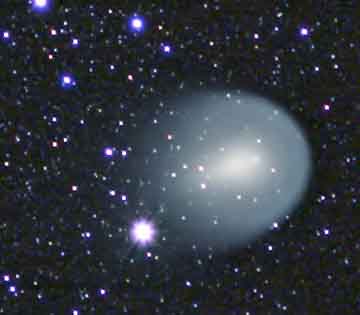
Expansive Comet Holmes NASA - November 21, 2007
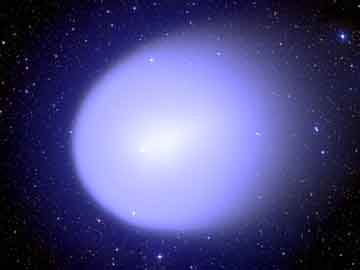
The spherical coma of Comet Holmes has swollen to a diameter of over 1.4 million kilometers, making the tenuous, dusty cloud even bigger than the Sun. Scattering sunlight, all that dust and gas came from the comet's remarkably active nucleus, whose diameter before the late October outburst was estimated to be a mere 3.4 kilometers. In this sharp image, recorded on November 14 with the Canada-France-Hawaii Telescope, stars are easily visible right through the outer coma, while the nucleus is buried inside the condensed, bright region. The bright region of the coma seems offset from the center, consistent with the idea that a large fragment drifted away from the nucleus and disintegrated, producing the comet's spectacular outburst. Of course, more recent images of Holmes also show the bright star Mirfak (Alpha Persei) shining through as the comet sweeps slowly through the constellation Perseus.
Incredible Comet Bigger than the Sun Space.com - November 17, 2007
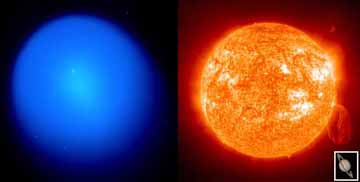
A comet that has delighted backyard astronomers in recent weeks after an unexpected eruption has now grown larger than the sun.
The sun remains by far the most massive object in the solar system, with an extended influence of particles that reaches all the planets. But the comparatively tiny Comet Holmes has released so much gas and dust that its extended atmosphere, or coma, is larger than the diameter of the sun. The comparison is clear in a new image.
The Inner Coma of Comet Holmes NASA - November 13, 2007
What's happening to Comet Holmes? The rare comet remains visible to the unaided eyes of northern observers as an unusual small puff ball in the constellation of Perseus. A high resolution set of images of the comet's inner coma, taken last week and shown above, reveals significant detail. Close inspection shows numerous faint streamers that are possibly the result of jets emanating from the comet's nucleus. Comet Holmes has remained surprisingly bright over the past week, with luminosity estimates ranging from between visual magnitudes 2 to 3, making it brighter than most stars visible on a dark sky. The above image of Comet Holmes was made with a small automated 0.38-meter telescope hirable over the web for a small fee.
A Tale of Comet Holmes NASA - November 10, 2007
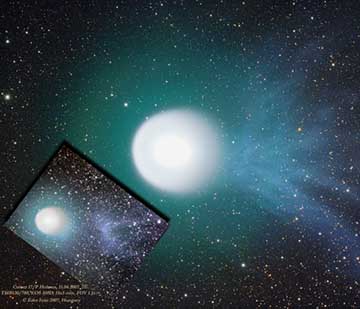
A beautiful blue ion tail has become visible in deep telescopic images of Comet Holmes. Pointing generally away from the Sun and also planet Earth, the comet's ion tail is seriously foreshortened by our extreme viewing angle. Still, enthusiastic comet watchers have remarked that on the whole, the compact but tentacled appearance suggests a jellyfish or even a cosmic calamari. This stunning view of the comet's greenish coma and blue tail was recorded on November 4 in clear skies near Budapest, Hungary. The colors are caused by molecules in the tenuous gas, like C2 (green) and CO+ (blue), fluorescing in sunlight. In a more recent development, the dramatic inset is a deep image from L'Aquila in central Italy on November 8, showing the ion tail disconnecting from the comet.
Skyscape with Comet Holmes NASA - November 9, 2007
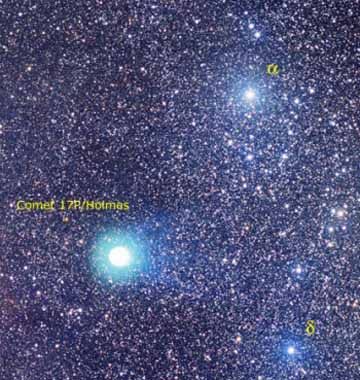
This gorgeous skyscape spans some 10 degrees across the heroic constellation Perseus, about the size of a generous binocular field of view. The deep exposure includes bright stars, emission nebulae, star clusters, and, of course, the famous Comet Holmes. To identify the celestial landmarks, just place your cursor over the image. The brightest star in view, Alpha Persei, is itself surrounded by a loose cluster of stars - the Alpha Per Moving Cluster - at a distance of about 600 light-years. But, at a distance of a mere 14 light-minutes bright Comet Holmes still dominates the scene with its fluorescing greenish coma and foreshortened blue tail.
Exploding Comet Holmes Catches Expert, Amateur Eyes National Geographic - November 6, 2007
The comet is exploding, and its coma, a cloud of gas and dust illuminated by the sun, has become bigger than the planet Jupiter.
The comet appears to lack the tail usually associated with such celestial bodies but can be seen in the northern sky - in the constellation Perseus - as a fuzzy spot of light about as bright as the stars in the Big Dipper.
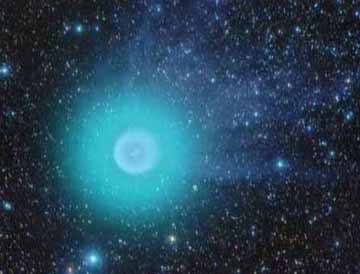
Comet Holmes Grows a Tail NASA - November 5, 2007
Comet Holmes continues to be an impressive sight to the unaided eye. The comet has diminished in brightness only slightly, and now clearly appears to have a larger angular extent than stars and planets. Astrophotographers have also noted a distinctly green appearance to the comet's coma over the past week. Pictured above over Spain in three digitally combined exposures, Comet 17P/Holmes now clearly sports a tail. The blue ion tail is created by the solar wind impacting ions in the coma of Comet Holmes and pushing them away from the Sun. Comet Holmes underwent an unexpected and dramatic increase in brightness starting only two weeks ago. The detail visible in Comet Holmes' tail indicates that the explosion of dust and gas that created this dramatic brightness increase is in an ongoing and complex event. Comet Holmes will move only slightly on the sky over during the next month.
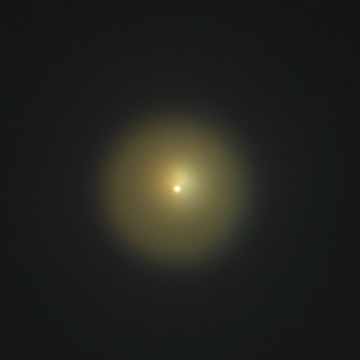
A Telescopic View of Erupting Comet Holmes NASA - October 28, 2007
What's happened to Comet Holmes? A normally docile comet discovered over 100 years ago, Comet 17P/Holmes suddenly became nearly one million times brighter last week, possibly over just a few hours. In astronomical terms, the comet brightened from magnitude 17, only visible through a good telescope, to magnitude 3, becoming visible with the unaided eye. Comet Holmes had already passed its closest to the Sun in 2007 May outside the orbit of Mars and was heading back out near Jupiter's orbit when the outburst occurred. The comet's sudden brightening is likely due to some sort of sunlight-reflecting outgassing event, possibly related to ice melting over a gas-filled cavern, or possibly even a partial breakup of the comet's nucleus. Pictured above through a small telescope last Thursday, Comet Holmes appeared as a fuzzy yellow spot, significantly larger in angular size than Earth-atmosphere blurred distant stars. Although Comet Holmes' orbit will place it in northern hemisphere skies for the next two years, whether it will best be viewed through a telescope or sunglasses remains unknown.
Comet 17P/Holmes Wikipedia
Comet Holmes (official designation: 17P/Holmes) is a periodic comet in the Solar System, discovered by the British amateur astronomer Edwin Holmes on November 6, 1892. Although normally a very faint object, Holmes became notable during its October 2007 return when it temporarily brightened by a factor of about half a million, in what was the largest known outburst by a comet, and became visible to the naked eye. It also briefly became the largest object in the solar system, as its coma (the thin dissipating dust ball around the comet) expanded to a diameter greater than that of the Sun (although its mass remained minuscule).
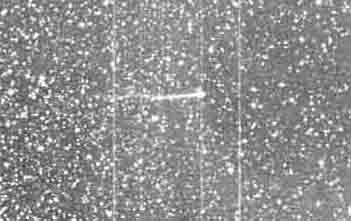
Comet Encke's Tail Ripped Off NASA - October 3, 2007
Swinging inside the orbit of Mercury, on April 20th periodic comet Encke encountered a blast from the Sun in the form of a Coronal Mass Ejection (CME). When CMEs, enormous clouds of energetic particles ejected from the Sun, slam into Earth's magnetosphere, they often trigger auroral displays. But in this case, the collison carried the tail of the comet away. The tail was likely ripped off by interacting magnetic fields rather than the mechanical pressure of the collision. Clicking on the two panel image will play a movie gif of the remarkable event as recorded by the Heliospheric Imager onboard the STEREO A spacecraft. In the movie, the time between frames is about 45 minutes, while the frames span about 14x20 million kilometers at the distance of the comet. Of course, similar collisions have happened before as the ancient comet loops through its 3.3 year solar orbit. So don't worry, Encke's tail grows back! Animation
Comet Encke Wikipedia
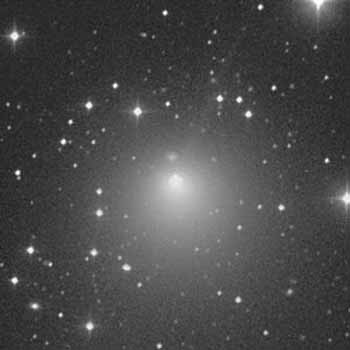
Comet Encke or Encke's Comet (official designation: 2P/Encke) is a periodic comet that completes an orbit of the Sun once every three years - the shortest period of any known comet. It was first recorded by Pierre Mechain in 1786, but it was not recognized as a periodic comet until 1819 when its orbit was computed by Johann Franz Encke; like Halley's Comet, it is unusual in being named after the calculator of its orbit rather than its discoverer. Like most other comets, it has a very low albedo, reflecting only 4.6% of the light it receives. The diameter of the nucleus of Encke's Comet is 4.8 km. During the November 2013 perihelion passage the comet is expected to brighten to apparent magnitude 7.
 SOHO: Comet McNaught Movie NASA - January 20, 2007
SOHO: Comet McNaught Movie NASA - January 20, 2007
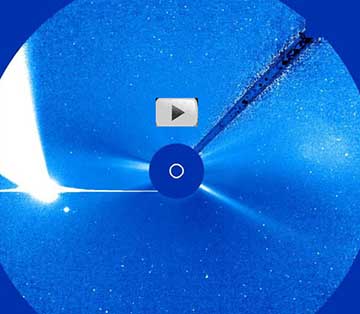
This frame from a spectacular time lapse movie shows Comet McNaught - the Great Comet of 2007 - sweeping through the inner solar system. The movie frames were recorded from January 12 through Jan 16 by a coronograph onboard the sun-staring SOHO spacecraft. Bright planet Mercury also glides dramatically through the field of view but the Sun itself remains fixed, hidden behind the coronograph's central occulting disk. The broad-tailed comet is so bright it almost overwhelms SOHO's sensitive camera designed to explore the fainter structures in the Sun's outer atmosphere. Comet McNaught's closest approach to the Sun (perihelion on January 12) was only 0.17 astronomical units, or about half the distance between the Sun and Mercury.
McNaught's Matinee NASA - January 19, 2007
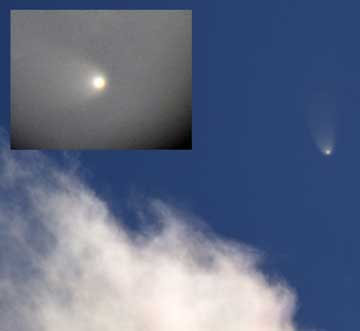
Comets grow bright when they're close to the Sun, basking in the intense solar radiation. Of course, they're also usually impossible to see against the overwhelming scattered sunlight. But surprising Comet McNaught - whose January 12 closest approach to the Sun (perihelion passage) was well inside the orbit of Mercury - gave an enjoyable performance in bright blue daytime skies. In fact, comet expert David Levy captured this remarkable inset (upper left) telescopic view of McNaught within an hour of perihelion, with the comet in broad daylight only about 7 degrees away from the Sun's position. Stefan Seip's wider daytime view of the comet and fluffy clouds was recorded approximately a day later. Seip used a polarizing filter and a telescope/camera set up near Stuttgart, Germany. No longer visible in broad daylight, Comet McNaught is now touring twilight southern skies.
Comet McNaught Over New Zealand NASA - January 18, 2007
After a remarkable performance in the northern hemisphere, the brightest comet in decades is now showing off in the south. Recorded during evening twilight on January 17, this view features the bright coma and gorgeous, sweeping tail of Comet McNaught (c/2006 P1) over Lake Horowhenua in Levin, a small town on New Zealand's North Island. Astronomer Noel Munford reports that the five second long digital camera exposure comes close to capturing the visual appearance of the comet in a sky coloured by smoke from distant brush fires in Australia. Discovered last summer by R. H. McNaught (Siding Spring Survey), the comet grew impressively bright in early January and has even been sighted in full daylight. In the coming days Comet McNaught will continue to move south, for now a spectacle in southern skies as it heads for the outer solar system.
Comet McNaught from New STEREO Satellite NASA - January 16, 2007
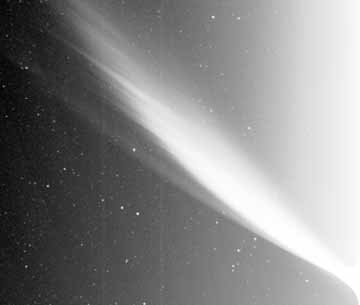
The brightest comet of recent decades was a surprising first sight for a new camera in space. The Sun Earth Connection Coronal and Heliospheric Investigation (SECCHI) instrument onboard the Solar TErrestrial RElations Observatory (STEREO) satellite had just opened up on January 11 when it snapped the above image of Comet McNaught. Visible was a spectacular view of the ion tail of Comet McNaught being swept away from the Sun by the solar wind in filamentary rays. The comet tail is seen to extend at least seven degrees across the above image, while the central coma is so bright it saturates. Comet McNaught is now reportedly so bright that it is visible even in broad daylight by blocking out the Sun with your hand. Comet McNaught has rounded the Sun and will slowly fade away for observers in Earth's Southern Hemisphere as it recedes from the Sun.
Comet McNaught NASA - January 15, 2007
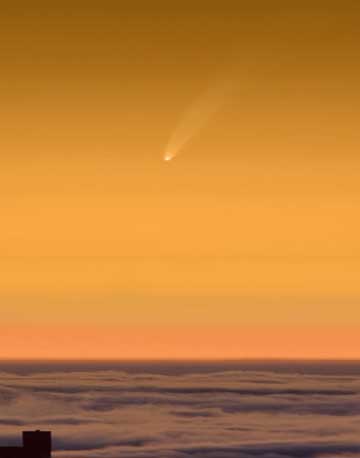
This past weekend Comet McNaught peaked at a brightness that surpassed even Venus. Fascinated sky enthusiasts in the Earth's northern hemisphere were treated to an instantly visible comet head and a faint elongated tail near sunrise and sunset. Recent brightness estimates had Comet McNaught brighter than magnitude -5 (minus five) over this past weekend, making it the brightest comet since Comet Ikeya-Seki in 1965, which was recorded at -7 (minus seven). The Great Comet of 2007 reached its brightest as it rounded the Sun well inside the orbit of Mercury. Over the next week Comet McNaught will begin to fade as it moves south and away from the Sun. The unexpectedly bright comet should remain visible to observers in the southern hemisphere with unaided eyes for the rest of January. The above image, vertically compressed, was taken at sunset last Friday from mountains above Catalonia, Spain.
C/2006 P1 Wikipedia
Comet McNaught, also known as the Great Comet of 2007 and given the designation C/2006 P1, is a non-periodic comet discovered on August 7, 2006 by British-Australian astronomer Robert H. McNaught using the Uppsala Southern Schmidt Telescope. It was the brightest comet in over 40 years, and was easily visible to the naked eye for observers in the Southern Hemisphere in January and February 2007. With an estimated peak magnitude of -5.5, the comet was the second brightest since 1935. Around perihelion on January 12, it was visible worldwide in broad daylight. Its tail measured an estimated 35 degrees in length at its peak. The brightness of C/2006 P1 near perihelion was enhanced by forward scattering.
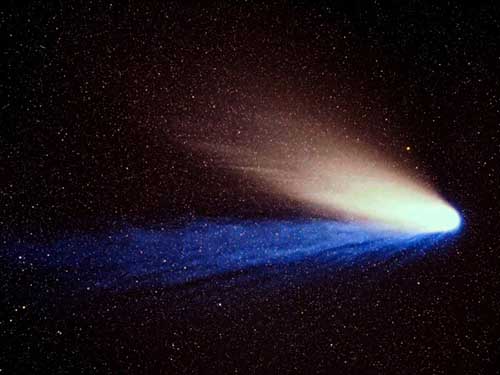
Comet Hale-Bopp (formally designated C/1995 O1) was perhaps the most widely observed comet of the 20th century and one of the brightest seen for many decades. It was visible to the naked eye for a record 18 months, twice as long as the previous record holder, the Great Comet of 1811.
Hale-Bopp was discovered on July 23, 1995, at a great distance from the Sun, raising expectations that the comet would brighten considerably by the time it passed close to Earth. Although predicting the brightness of comets with any degree of accuracy is very difficult, Hale-Bopp met or exceeded most predictions when it passed perihelion on April 1, 1997. The comet was dubbed the Great Comet of 1997.
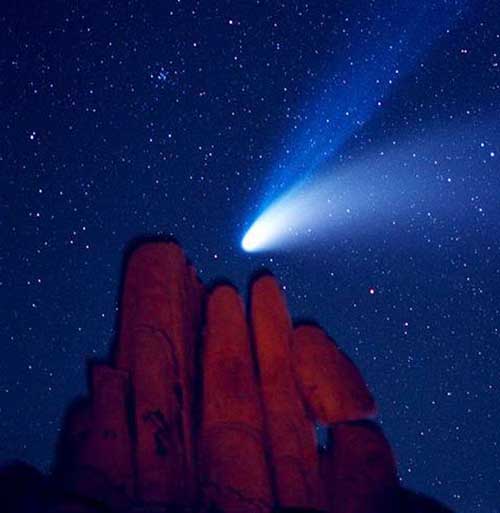
Comet Hale-Bopp Over Indian Cove
NASA - November 24, 2013Comet Hale-Bopp, the Great Comet of 1997, was quite a sight. In the above photograph taken on 1997 April 6, Comet Hale-Bopp was imaged from the Indian Cove Campground in the Joshua Tree National Park in California, USA. A flashlight was used to momentarily illuminate foreground rocks in this six minute exposure. An impressive blue ion tail was visible above a sunlight-reflecting white dust tail. Comet Hale-Bopp remained visible to the unaided eye for over a year before returning to the outer Solar System and fading. As Comet ISON approaches the Sun this week, sky enthusiasts around the Earth are waiting to see if its tails will become even more spectacular than those displayed by Comet Hale-Bopp.
Marshall Applewhite, leader of the doomsday cult, Heaven's Gate, who organized a mass suicide in hopes of spiritually riding along with a UFO he thought followed the Hale-Bopp comet.
In November 1996 amateur astronomer Chuck Shramek of Houston, Texas took a CCD image of the comet, which showed a fuzzy, slightly elongated object nearby. When his computer sky-viewing program did not identify the star, Shramek called the Art Bell radio program Coast to Coast AM to announce that he had discovered a "Saturn-like object" following Hale-Bopp. UFO enthusiasts, such as remote viewing proponent Courtney Brown, soon concluded that there was an alien spacecraft following the comet.
Several astronomers, including Alan Hale, claimed the object was simply an 8.5-magnitude star, SAO141894, which did not appear on Shramek's computer program because the user preferences were set incorrectly. Later, Art Bell even claimed to have obtained an image of the object from an anonymous astrophysicist who was about to confirm its discovery. However, astronomers Olivier Hainaut and David J. Tholen of the University of Hawaii stated that the alleged photo was an altered copy of one of their own comet images.
A few months later, in March 1997, the cult Heaven's Gate committed mass suicide with the intention of teleporting to a spaceship they believed was flying behind the comet.
Nancy Lieder, a self-proclaimed contactee who claims to receive messages from aliens through an implant in her brain, stated that Hale-Bopp was a fiction designed to distract the population from the coming arrival of "Nibiru" or "Planet X", a giant planet whose close passage would disrupt the Earth's rotation, causing global cataclysm. Although Lieder's original date for the apocalypse, May 2003, has now passed, the imminent arrival of Nibiru is still predicted by various conspiracy websites, most of whom tie it to the 2012 phenomenon. This date also passed without incident.
Comet Hale-Bopp Wikipedia
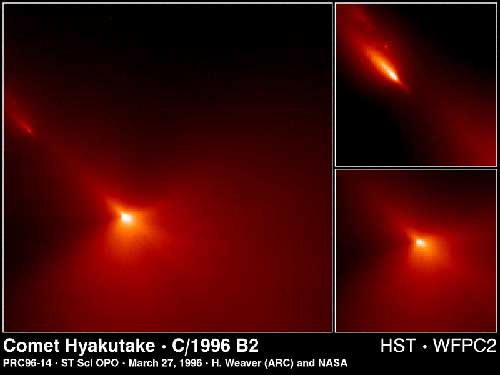
Comet Hyakutake formally designated C/1996 B2) is a comet, discovered on 31 January 1996, that passed very close to Earth in March of that year. It was dubbed The Great Comet of 1996; its passage near the Earth was one of the closest cometary approaches of the previous 200 years. Hyakutake appeared very bright in the night sky and was widely seen around the world. The comet temporarily upstaged the much anticipated Comet Hale-Bopp, which was approaching the inner Solar System at the time.
Scientific observations of the comet led to several discoveries. Most surprising to cometary scientists was the first discovery of X-ray emission from a comet, believed to have been caused by ionized solar wind particles interacting with neutral atoms in the coma of the comet. The Ulysses spacecraft unexpectedly crossed the comet's tail at a distance of more than 500 million kilometres from the nucleus, showing that Hyakutake had the longest tail known for a comet.
Hyakutake is a long-period comet. Before its most recent passage through the Solar System, its orbital period was about 17,000 years, but the gravitational perturbation of the giant planets has increased this period to 70,000 years.
Comet Hyakutake Wikipedia
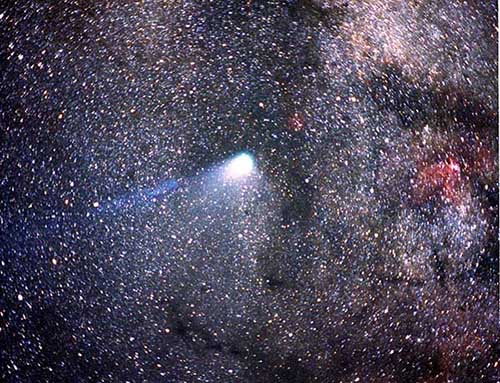
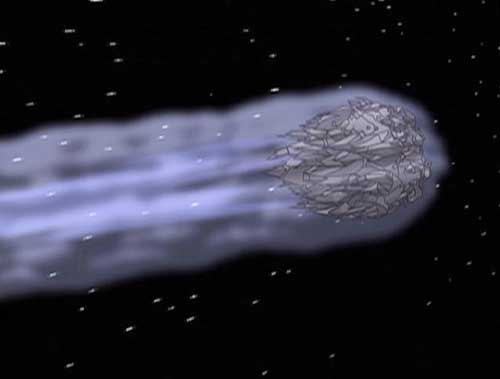
Halley's Comet or Comet Halley officially designated 1P/Halley, is the best-known of the short-period comets and is visible from Earth every 75-76 years. Halley's Comet is the only short-period comet that is clearly visible to the naked eye from Earth, and thus the only naked-eye comet that might appear twice in a human lifetime. Other naked-eye comets may be brighter and more spectacular, but will appear only once in thousands of years.
Halley's Comet returns to the inner Solar System have been observed and recorded by astronomers since at least 240 BCE. Clear records of the comet's appearances were made by Chinese, Babylonian, and medieval European chroniclers, but were not recognized as reappearances of the same object at the time. The comet's periodicity was first determined in 1705 by English astronomer Edmond Halley, after whom it is now named. Halley's Comet last appeared in the inner Solar System in 1986 and will next appear in mid-2061.
During its 1986 apparition, Halley's Comet became the first to be observed in detail by spacecraft, providing the first observational data on the structure of a comet nucleus and the mechanism of coma and tail formation. These observations supported a number of longstanding hypotheses about comet construction, particularly Fred Whipple's "dirty snowball" model, which correctly predicted that Halley's Comet would be composed of a mixture of volatile ices -such as water, carbon dioxide and ammonia -and dust. The missions also provided data which substantially reformed and reconfigured these ideas; for instance it is now understood that the surface of Halley's Comet is largely composed of dusty, non-volatile materials, and that only a small portion of it is icy.
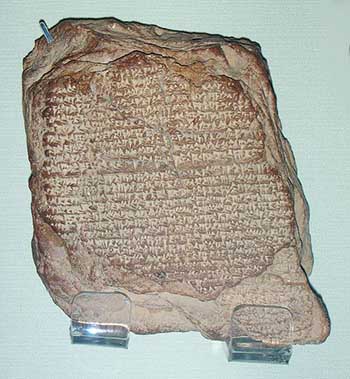
Halley may have been recorded as early as 467 BCE, but this is uncertain. A comet was recorded in ancient Greece between 468 and 466 BCE; its timing, location, duration, and associated meteor shower all suggest it was Halley. According to Pliny the Elder, that same year a meteorite fell in the town of Aegospotami, in Thrace. He described it as brown in color and the size of a wagon load.Chinese chroniclers also mention a comet in that year.
The first certain appearance of Halley's Comet in the historical record is a description from 240 BCE, in the Chinese chronicle Records of the Grand Historian or Shiji, which describes a comet that appeared in the east and moved north. The only surviving record of the 164 BCE apparition is found on two fragmentary Babylonian tablets, now owned by the British Museum.
The apparition of 87 BCE was recorded in Babylonian tablets which state that the comet was seen "day beyond day" for a month. This appearance may be recalled in the representation of Tigranes the Great, an Armenian king who is depicted on coins with a crown that features, according to Vahe Gurzadyan and R. Vardanyan, "a star with a curved tail that may represent the passage of Halley's Comet in 87 BCE." Gurzadyan and Vardanyan argue that "Tigranes could have seen Halley's Comet when it passed closest to the Sun on August 6 in 87 BCE" as the comet would have been a "most recordable event"; for ancient Armenians it could have heralded the New Era of the brilliant King of Kings.
The apparition of 12 BCE was recorded in the Book of Han by Chinese astronomers of the Han Dynasty who tracked it from August through October. It passed within 0.16 AU of Earth. Halley's appearance in 12 BCE, only a few years distant from the conventionally assigned date of the birth of Jesus Christ, has led some theologians and astronomers to suggest that it might explain the biblical story of the Star of Bethlehem. There are other explanations for the phenomenon, such as planetary conjunctions, and there are also records of other comets that appeared closer to the date of Jesus' birth.
If, as has been suggested, the reference in the Talmud to "a star which appears once in seventy years that makes the captains of the ships err" refers to Halley's Comet, it may be a reference to the 66 CE appearance, because this passage is attributed to the Rabbi Yehoshua ben Hananiah. This apparition was the only one to occur during ben Hananiah's lifetime.
The 141 CE apparition was recorded in Chinese chronicles. The 374 CE and 607 approaches each came within 0.09 AU of Earth.[57] The 684 CE apparition was recorded in Europe in one of the sources used by the compiler of the 1493 Nuremberg Chronicles. Chinese records also report it as the "broom star".
In 837, Halley's Comet may have passed as close as 0.03 AU (3.2 million miles; 5.1 million kilometers) from Earth, by far its closest approach. Its tail may have stretched 60 degrees across the sky. It was recorded by astronomers in China, Japan, Germany and the greater Middle East. In 912, Halley's Comet is recorded in the Annals of Ulster, which state "A dark and rainy year. A comet appeared."
In 1066, the comet was seen in England and thought to be an omen: later that year Harold II of England died at the Battle of Hastings; it was a bad omen for Harold, but a good omen for the man who defeated him, William the Conqueror. The comet is represented on the Bayeux Tapestry as a fiery star, and the surviving accounts describe it as appearing to be four times the size of Venus and shining with a light equal to a quarter of that of the Moon. Halley came within 0.10 AU of Earth at that time.
This appearance of the comet is also noted in the Anglo-Saxon Chronicle. Eilmer of Malmesbury may have seen Halley previously in 989, as he wrote of it in 1066: "You've come, have you? ... You've come, you source of tears to many mothers, you evil. I hate you! It is long since I saw you; but as I see you now you are much more terrible, for I see you brandishing the downfall of my country. I hate you!"
The Irish Annals of the Four Masters recorded the comet as "A star [that] appeared on the seventh of the Calends of May, on Tuesday after Little Easter, than whose light the brilliance or light of the moon was not greater; and it was visible to all in this manner till the end of four nights afterwards." Chaco Native Americans in New Mexico may have recorded the 1066 apparition in their petroglyphs.
The 1145 apparition was recorded by the monk Eadwine. The 1986 apparition exhibited a fan tail similar to Eadwine's drawing. Some claim that Genghis Khan was inspired to turn his conquests toward Europe by the 1222 apparition.
The 1301 apparition may have been seen by the artist Giotto di Bondone, who represented the Star of Bethlehem as a fire-colored comet in the Nativity section of his Arena Chapel cycle, completed in 1305. No record survives of the 1378 apparition.
In 1456, the year of Halley's next apparition, the Ottoman Empire invaded the Kingdom of Hungary, culminating in the Siege of Belgrade in July of that year. In a Papal Bull, Pope Calixtus III ordered special prayers be said for the city's protection. Halley's apparition of 1456 was also witnessed in Kashmir and depicted in great detail by Srivara, a Sanskrit poet and biographer to the Sultans of Kashmir. He read the apparition as a cometary portent of doom foreshadowing the imminent fall of Sultan Zayn al-Abidin ( AD 1418/1420-1470). After witnessing a bright light in the sky (which most historians have identified as Halley's Comet, visible in Ethiopia in 1456), Emperor Zara Yaqob, ruler from 1434 to 1468, founded the city of Debre Berhan (tr. City of Light) and made it his capital for the remainder of his reign.
Halley's periodic returns have been subject to scientific investigation since the 16th century. The three apparitions from 1531 to 1682 were noted by Edmond Halley, enabling him to predict its 1759 return. Streams of vapor observed during the comet's 1835 apparition prompted astronomer Friedrich Wilhelm Bessel to propose that the jet forces of evaporating material could be great enough to significantly alter a comet's orbit.
The 1910 approach, which came into naked-eye view around April 10th and came to perihelion on April 20th was notable for several reasons: it was the first approach of which photographs exist, and the first for which spectroscopic data were obtained. Furthermore, the comet made a relatively close approach of 0.15AU, making it a spectacular sight. Indeed, on May 19th, Earth actually passed through the tail of the comet. One of the substances discovered in the tail by spectroscopic analysis was the toxic gas cyanogen, which led astronomer Camille Flammarion to claim that, when Earth passed through the tail, the gas "would impregnate the atmosphere and possibly snuff out all life on the planet." His pronouncement led to panicked buying of gas masks and quack "anti-comet pills" and "anti-comet umbrellas" by the public. In reality, as other astronomers were quick to point out, the gas is so diffuse that the world suffered no ill effects from the passage through the tail.
The comet was also fertile ground for hoaxes. One that reached major newspapers claimed that the Sacred Followers, a supposed Oklahoma religious group, attempted to sacrifice a virgin to ward off the impending disaster, but were stopped by the police.
American satirist and writer Mark Twain was born on 30 November 1835, exactly two weeks after the comet's perihelion. In his autobiography, published in 1909, he said,
Twain died on 21 April 1910, the day following the comet's subsequent perihelion.[80] The 1985 fantasy film The Adventures of Mark Twain was inspired by the quotation.
Halley's 1910 apparition is distinct from the Great Daylight Comet of 1910, which surpassed Halley in brilliance and was actually visible in broad daylight for a short period, approximately four months before Halley made its appearance.
On 12 February 1991, at a distance of 14.4 AU rom the Sun, Halley displayed an outburst that lasted for several months, releasing a cloud of dust 300,000 km across. The outburst likely started in December 1990, and then the comet brightened from magnitude 24.3 to magnitude 18.9. Halley was most recently observed in 2003 by three of the Very Large Telescopes at Paranal, Chile, when Halley's magnitude was 28.2. The telescopes observed Halley, at the faintest and farthest any comet has ever been imaged, in order to verify a method for finding very faint trans-Neptunian objects. Astronomers are now able to observe the comet at any point in its orbit.
The next predicted perihelion of Halley's Comet is July 28, 2061, when it is expected to be better positioned for observation than during the 1985-1986 apparition, as it will be on the same side of the Sun as Earth.
Halley's comet 'was spotted by the ancient Greeks' BBC - September 11, 2010
A celestial event seen by the ancient Greeks may be the earliest sighting of Halley's comet, new evidence suggests. According to ancient writers, a large meteorite smacked into northern Greece between 466BC and 467BC. The writers also described a comet in the sky at the time the meteorite fell to Earth, but this detail has received little attention, say the researchers. Comet Halley would have been visible for about 80 days in 466 BC, researchers write in the Journal of Cosmology. New Scientist magazine reports that, until now, the earliest probable sighting of the comet was an orbit in 240BC, an event recorded by Chinese astronomers. If the new findings are confirmed, the researchers will have pushed back the date of the first observation of Comet Halley by 226 years.
Historically, comets were thought to be unlucky, or even interpreted as attacks by heavenly beings against terrestrial inhabitants. Some authorities interpret references to "falling stars" in Gilgamesh, Revelation and the Book of Enoch as references to comets, or possibly bolides - either an extraterrestrial body that collides with the Earth, or to an exceptionally bright, fireball-like meteor regardless of whether it ultimately impacts the surface.
In the first book of his Meteorology, Aristotle propounded the view of comets that would hold sway in Western thought for nearly two thousand years. He rejected the ideas of several earlier philosophers that comets were planets, or at least a phenomenon related to the planets, on the grounds that while the planets confined their motion to the circle of the Zodiac, comets could appear in any part of the sky.
Instead, he described comets as a phenomenon of the upper atmosphere, where hot, dry exhalations gathered and occasionally burst into flame. Aristotle held this mechanism responsible for not only comets, but also meteors, the aurora borealis, and even the Milky Way.
A few later classical philosophers did dispute this view of comets. Seneca the Younger, in his Natural Questions, observed that comets moved regularly through the sky and were undisturbed by the wind, behavior more typical of celestial than atmospheric phenomena. While he conceded that the other planets do not appear outside the Zodiac, he saw no reason that a planet-like object could not move through any part of the sky, humanity's knowledge of celestial things being very limited.
However, the Aristotelean viewpoint proved more influential, and it was not until the 16th century that it was demonstrated that comets must exist outside the earth's atmosphere.
In 1577, a bright comet was visible for several months. The Danish astronomer Tycho Brahe used measurements of the comet's position taken by himself and other, geographically separated observers to determine that the comet had no measureable parallax. Within the precision of the measurements, this implied the comet must be at least four times more distant from the earth than the moon.
Although comets had now been demonstrated to be in the heavens, the question of how they moved through the heavens would be debated for most of the next century. Even after Johannes Kepler had determined in 1609 that the planets moved about the sun in elliptical orbits, he was reluctant to believe that the laws that governed the motions of the planets should also influence the motion of other bodies - he believed that comets travel among the planets along straight lines. Galileo Galilei, although a staunch Copernicanist, rejected Tycho's parallax measurements and held to the Aristotelean notion of comets moving on straight lines through the upper atmosphere.
The first suggestion that Kepler's laws of planetary motion should also apply to the comets was made by William Lower in 1610.
In the following decades, other astronomers, including Pierre Petit, Giovanni Borelli, Adrien Auzout, Robert Hooke, Johann Baptist Cysat, and Jean-Dominique Cassini, all argued for comets curving about the sun on elliptical or parabolic paths, while others, such as Christian Huygens and Johannes Hevelius, supported comets' linear motion.
The matter was resolved by the bright comet that was discovered by Gottfried Kirch on November 14, 1680. Astronomers throughout Europe tracked its position for several months.
In his Principia Mathematica of 1687, Isaac Newton proved that an object moving under the influence of his inverse square law of universal gravitation must trace out an orbit shaped like one of the conic sections, and he demonstrated how to fit a comet's path through the sky to a parabolic orbit, using the comet of 1680 as an example.
Newton described comets as compact, solid, fixed, and durable bodies: in one word, a kind of planets, which move in very oblique orbits, every way, with the greatest freedom, persevering in their motions even against the course and direction of the planets; and their tail as a very thin, slender vapor, emitted by the head, or nucleus of the comet, ignited or heated by the sun.
Comets also seemed to Newton absolutely requisite for the conservation of the water and moisture of the planets; from their condensed vapors and exhalations all that moisture which is spent on vegetations and putrefactions, and turned into dry earth, might be resupplied and recruited; for all vegetables were thought to increase wholly from fluids, and turn by putrefaction into earth. Hence the quantity of dry earth must continually increase, and the moisture of the globe decrease, and at last be quite evaporated, if it have not a continual supply. Newton suspected that the spirit which makes the finest, subtilest, and best part of our air, and which is absolutely requisite for the life and being of all things, came principally from the comets.
In 1705, Edmond Halley applied Newton's method to twenty-four cometary apparitions that had occurred between 1337 and 1698. He noted that three of these, the comets of 1531, 1607, and 1682, had very similar orbital elements, and he was further able to account for the slight differences in their orbits in terms of gravitational perturbation by Jupiter and Saturn. Confident that these three apparitions had been three appearances of the same comet, he predicted that it would appear again in 1758-9.
(Earlier, Robert Hooke had identified the comet of 1664 with that of 1618, [N] while Jean-Dominique Cassini had suspected the identity of the comets of 1577, 1665, and 1680. Both were incorrect.)
Halley's predicted return date was later refined by a team of three French mathematicians: Alexis Clairaut, Joseph Lalande, and Nicole-Reine Lepaute, who predicted the date of the comet's 1759 perihelion to within one month's accuracy.
When the comet returned as predicted, it became known as Comet Halley or Halley's Comet (its official designation is 1P/Halley). Its next appearance is due in 2061.
Among the comets with short enough periods to have been observed several times in the historical record, Comet Halley is unique in consistently being bright enough to be visible to the naked eye.
Since the confirmation of Comet Halley's periodicity, many other periodic comets have been discovered through the telescope.
The second comet to be discovered to have a periodic orbit was Comet Encke (official designation 2P/Encke). Over the period 1819-1821 the German mathematician and physicist Johann Franz Encke computed orbits for a series of cometary apparitions observed in 1786, 1795, 1805, and 1818, concluded they were same comet, and successfully predicted its return in 1822.
As early as the 18th century, some scientists had made correct hypotheses as to comets' physical composition. In 1755, Immanuel Kant hypothesized that comets are composed of some volatile substance, whose vaporization gives rise to their brilliant displays near perihelion. In 1836, the German mathematician Friedrich Wilhelm Bessel, after observing streams of vapor in the 1835 apparition of Comet Halley, proposed that the jet forces of evaporating material could be great enough to significantly alter a comet's orbit and argued that the non-gravitational movements of Comet Encke resulted from this mechanism.
However, another comet-related discovery overshadowed these ideas for nearly a century. Over the period 1864-1866 the Italian astronomer Giovanni Schiaparelli computed the orbit of the Perseid meteors, and based on orbital similarities, correctly hypothesized that the Perseids were fragments of Comet Swift-Tuttle. The link between comets and meteor showers was dramatically underscored when in 1872, a major meteor shower occurred from the orbit of Comet Biela, which had been observed to split into two pieces during its 1846 apparition, and never seen again after 1852. A "gravel bank" model of comet structure arose, according to which comets consist of loose piles of small rocky objects, coated with an icy layer.
By 1900, seventeen comets had been observed at more than one perihelion passage and recognized as periodic comets.

Comets in Ancient Cultures
- NASA November 20, 2013Comets have inspired dread, fear, and awe in many different cultures and societies around the world and throughout time. They have been branded with such titles as "the Harbinger of Doom" and "the Menace of the Universe." They have been regarded both as omens of disaster and messengers of the gods. Why is it that comets are some of the most feared and venerated objects in the night sky? Why did so many cultures cringe at the sight of a comet? They believed costs were messages from the gods or a fiery sword blazing across the night sky, a traditional sign of war and death. The Roman prophecies, the "Sibylline Oracles," spoke of a "great conflagration from the sky, falling to earth," while the most ancient known mythology, the Babylonian "Epic of Gilgamesh," described fire, brimstone, and flood with the arrival of a comet.
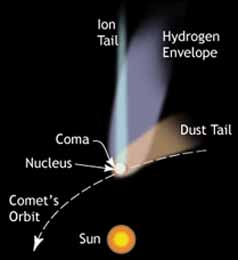
As a comet approaches the inner Solar System, solar radiation causes the volatile materials within the comet to vaporize and stream out of the nucleus, carrying dust away with them. The streams of dust and gas thus released form a huge and extremely thin atmosphere around the comet called the "coma", and the force exerted on the coma by the Sun's radiation pressure and solar wind cause an enormous "tail" to form pointing away from the Sun.
Comets can typically display a coma several thousand kilometers in diameter, with the size being dependent on the comet's distance from the sun and the size of the nucleus. The latter is important because since jets generally spring up on the side of the nucleus facing the sun (that side gets warmest), and since large nuclei have a greater surface area facing the sun, then there is the potential for larger numbers of jets and greater amounts of gas and dust feeding the coma.
One of the largest comets in history was the Great Comet of 1811. It was one of the few comets in history to be discovered with a relatively small telescope at an unusually great distance from the sun, in this case over half-way to the planet Jupiter's orbit. The nucleus has been estimated as between 30 and 40 kilometers in diameter. At one point during September to October 1811 the coma reached a diameter roughly equivalent to the diameter of the sun and was a very notable naked-eye object seen by people around the world.
Even though the coma can become quite large, its size can actually decrease about the time it crosses the orbit of Mars. At this distance the particles streaming out from the sun provide enough force so as to act as a wind and will literally blow the gas and dust particles away from the nucleus and coma. This disruption is the process responsible for a comet's tail, the most spectacular feature of a comet.
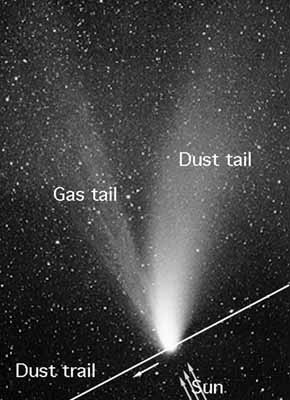
A comet tail - and coma - are features visible in comets when they are illuminated by the Sun and may become visible from Earth when a comet passes through the inner Solar System. As a comet approaches the inner Solar System, solar radiation causes the volatile materials within the comet to vaporize and stream out of the nucleus, carrying dust away with them. Separate tails are formed of dust and gases, becoming visible through different phenomena; the dust reflects sunlight directly and the gases glow from ionization. Most comets are too faint to be visible without the aid of a telescope, but a few each decade become bright enough to be visible to the naked eye. Continue reading
Colossal tail trails dying star BBC - August 15, 2007
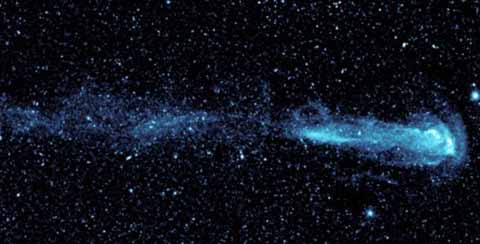
A distant star that hurtles through space at extraordinary speeds has a huge, comet-like tail trailing in its wake, astronomers say.
The appendage, which measures a colossal 13 light years in length, was spotted by Nasa's Galaxy Evolution Explorer (Galex) space telescope. The researchers said that nothing like it had ever been spotted around a star. They believe the star, known as Mira, will help them to study what happens as stars meet their demise.
About once a year, on the average, there will appear a comet bright enough to be visible with the naked eye, and the so-called "Great Comets," which are those that are conspicuous to the naked eyes of even non-astronomers, appear about once every decade or so.
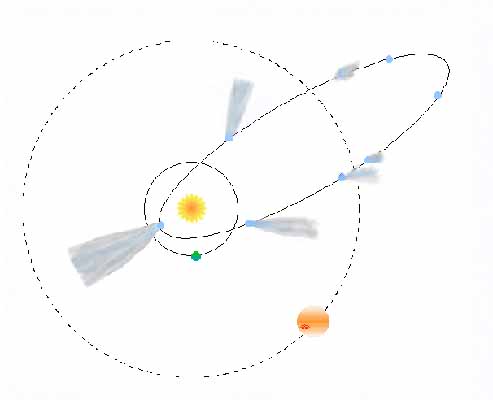
Comets travel around the sun in paths called 'ellipses'.
Comets have highly elliptical orbits that bring them very close to the Sun and swing them deeply into space, often beyond the orbit of Pluto. While most of the planets' orbits are near-circles, the orbits of most comets are extremely elongated ellipses. That point on the comet's orbit that is closest to the sun is called "perihelion." Because a comet experiences its strongest solar heating at its perihelion point, that is usually when it is brightest.
Occasionally, comets have been known to experience "outbursts" when their brightnesses increase dramatically within a short period of time. This can be due to a fresh eruption of new material from a comet's surface, or sometimes this occurs when the nucleus splits into two or more pieces, exposing previously hidden sections of its material to the sun's heat for the first time.
Some comets travel is such long orbit that they are near the sun once in thousands of years. All comets are part of the suns family, just as the Earth and the other planets.
As comets approach the Sun they develop enormous tails of luminous material that extend for millions of kilometers from the head, away from the Sun. When far from the Sun, the nucleus is very cold and its material is frozen solid within the nucleus. In this state comets are sometimes referred to as a "dirty iceberg" or "dirty snowball," since over half of their material lumps of frozen gas and rock.
When a comet approaches within close to the Sun, the surface of the nucleus begins to warm, and volatiles evaporate. The evaporated molecules boil off and carry small solid particles with them, forming the comet's coma of gas and dust.
When the nucleus is frozen, it can be seen only by reflected sunlight. However, when a coma develops, dust reflects still more sunlight, and gas in the coma absorbs ultraviolet radiation and begins to fluoresce. At about 5 AU from the Sun, fluorescence usually becomes more intense than reflected light.
As the comet absorbs ultraviolet light, chemical processes release hydrogen, which escapes the comet's gravity, and forms a hydrogen envelope. This envelope cannot be seen from Earth because its light is absorbed by our atmosphere, but it has been detected by spacecraft.
The Sun's radiation pressure and solar wind accelerate materials away from the comet's head at differing velocities according to the size and mass of the materials. Thus, relatively massive dust tails are accelerated slowly and tend to be curved. The ion tail is much less massive, and is accelerated so greatly that it appears as a nearly straight line extending away from the comet opposite the Sun.
Each time a comet visits the Sun, it loses some of its volatiles. Eventually, it becomes just another rocky mass in the solar system. For this reason, comets are said to be short-lived, on a cosmological time scale. Many scientists believe that some asteroids are extinct comet nuclei, comets that have lost all of their volatiles.
Comets probably formed at the same time as the Sun and planets, about 4.5 billion years ago. But many of them were kicked far from the Sun by the powerful gravity of the outer planets. The make up comets is found in sedimentary rocks on Earth.
Astronomers suspect that as many as one trillion of these objects reside in a shell, called the Oort Cloud, that extends as much as a light-year from the Sun. Because comets are so tiny, though, no one has ever seen a cometary body inside the Oort Cloud.
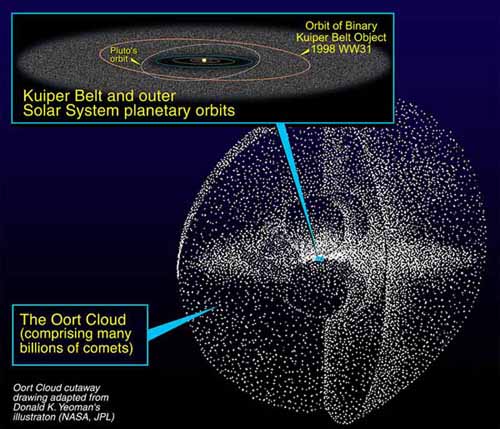
TheOort cloud is a postulated spherical cloud of comets situated about 50,000 to 100,000 AU from the Sun. This is approximately 1000 times the distance from the Sun to Pluto or roughly one light year, almost a quarter of the distance from the Sun to Proxima Centauri, the star nearest the Sun.
The Oort cloud would have its inner disk at the ecliptic from the Kuiper belt. Although no direct observations have been made of such a cloud, it is believed to be the source of most or all comets entering the inner solar system (some short-period comets may come from the Kuiper belt), based on observations of the orbits of comets.
In 1932 Ernst Opik, an Estonian astronomer, proposed that comets originate in an orbiting cloud situated at the outermost edge of the solar system.
In 1950 the idea was revived and proposed by Dutch astronomer Jan Hendrick Oort to explain an apparent contradiction: comets are destroyed by several passes through the inner solar system, yet if the comets we observe had existed since the origin of the solar system, all would have been destroyed by now. According to the hypothesis, the Oort cloud contains millions of comet nuclei, which are stable because the sun's radiation is very weak at their distance.
The cloud provides a continual supply of new comets, replacing those that are destroyed. It is believed that the total mass of comets in the Oort cloud is many times that of Earth, and estimates range between five and 100 Earth masses. It is a remnant of the original nebula that collapsed to form the Sun and planets five billion years ago, and is loosely bound to the solar system.
The most widely-accepted hypothesis of its formation is that the Oort cloud's objects initially formed much closer to the Sun as part of the same process that formed the planets and asteroids, but that gravitational interaction with young gas giants such as Jupiter ejected them into extremely long elliptical or parabolic orbits. This process also served to scatter the objects out of the ecliptic plane, explaining the cloud's spherical distribution. While on the distant outer regions of these orbits, gravitational interaction with nearby stars further modified their orbits to make them more circular. It is thought that other stars are likely to possess Oort clouds of their own, and that the outer edges of two nearby stars' Oort clouds may sometimes overlap, causing the occasional intrusion of a comet into the inner solar system. The star with the greatest possibility of perturbing the Oort cloud in the next 10 million years is Gliese 710.
Billions more of these icy bodies orbit the Sun in the Kuiper Belt, which begins just beyond the orbit of Neptune. Astronomers have discovered several dozen large, icy bodies orbiting beyond Neptune, and perhaps a couple of dozen smaller ones.
English astronomer Edmund Halley was the first person to suggest that comets are members of our solar system. Halley thought that several of the bright comets recorded long before he was born might really be a single comet approaching the Sun once every 76 years or so. The comet was recorded in 1531, 1607, and 1682. Halley predicted the comet would appear again in 1758. When it did, Halley's theory was proved correct. Comet Halley was named in his honor. It last approached the Sun in 1986, and will return again in 2061.
Several countries sent probes to study Comet Halley in 1986. In particular, the European Giotto spacecraft imaged the comet from close range. It found that Halley is about 10 miles (16 km) long and five miles (8 km) wide, and is coated with organic molecules that make Halley's surface darker than charcoal. Giotto's images showed "jets" of gas spewing off the comet's surface. These jets can be strong enough to change a comet's orbit.
Many comets have probably slammed into Earth during our planet's history, causing global destruction. In 1994, Comet Shoemaker-Levy 9 rammed into Jupiter. Jupiter's powerful gravity pulled the comet apart long before it reached Jupiter, so the planet was pelted by almost two dozen impacts, which created Earth-sized scars in Jupiter's cloud tops. Some of these dark markings lasted for several months.
Although comets had now been demonstrated to be in the heavens, the question of how they moved through the heavens would be debated for most of the next century. Even after Johannes Kepler had determined in 1609 that the planets moved about the sun in elliptical orbits, he was reluctant to believe that the laws that governed the motions of the planets should also influence the motion of other bodies - he believed that comets travel among the planets along straight lines. Galileo Galilei, although a staunch Copernicanist, rejected Tycho's parallax measurements and held to the Aristotelian notion of comets moving on straight lines through the upper atmosphere.
The first suggestion that Kepler's laws of planetary motion should also apply to the comets was made by William Lower in 1610. In the following decades other astronomers, including Pierre Petit, Giovanni Borelli, Adrien Auzout, Robert Hooke, Johann Baptist Cysat, and Giovanni Domenico Cassini all argued for comets curving about the sun on elliptical or parabolic paths, while others, such as Christian Huygens and Johannes Hevelius, supported comets' linear motion.
The matter was resolved by the bright comet that was discovered by Gottfried Kirch on November 14, 1680. Astronomers throughout Europe tracked its position for several months. In 1681, the Saxon pastor Georg Samuel Doerfel set forth his proofs that comets are heavenly bodies moving in parabolas of which the sun is the focus. Then Isaac Newton, in his Principia Mathematica of 1687, proved that an object moving under the influence of his inverse square law of universal gravitation must trace out an orbit shaped like one of the conic sections, and he demonstrated how to fit a comet's path through the sky to a parabolic orbit, using the comet of 1680 as an example.
In 1705, Edmond Halley applied Newton's method to twenty-four cometary apparitions that had occurred between 1337 and 1698. He noted that three of these, the comets of 1531, 1607, and 1682, had very similar orbital elements, and he was further able to account for the slight differences in their orbits in terms of gravitational perturbation by Jupiter and Saturn. Confident that these three apparitions had been three appearances of the same comet, he predicted that it would appear again in 1758-9. Earlier, Robert Hooke had identified the comet of 1664 with that of 1618, while Jean-Dominique Cassini had suspected the identity of the comets of 1577, 1665, and 1680. Both were incorrect. Halley's predicted return date was later refined by a team of three French mathematicians: Alexis Clairaut, Joseph Lalande, and Nicole-Reine Lepaute, who predicted the date of the comet's 1759 perihelion to within one month's accuracy. When the comet returned as predicted, it became known as Comet Halley or Halley's Comet (its official designation is 1P/Halley). Its next appearance will be in 2061.
Among the comets with short enough periods to have been observed several times in the historical record, Comet Halley is unique in consistently being bright enough to be visible to the naked eye. Since the confirmation of Comet Halley's periodicity, many other periodic comets have been discovered through the telescope. The second comet to be discovered to have a periodic orbit was Comet Encke (official designation 2P/Encke). Over the period 1819-1821 the German mathematician and physicist Johann Franz Encke computed orbits for a series of cometary apparitions observed in 1786, 1795, 1805, and 1818, concluded they were same comet, and successfully predicted its return in 1822. By 1900, seventeen comets had been observed at more than one perihelion passage and recognized as periodic comets. As of April 2006, 175 comets have achieved this distinction, though several have since been destroyed or lost.
Isaac Newton described comets as compact, solid, fixed, and durable bodies: in other words, a kind of planet, which move in very oblique orbits, every way, with the greatest freedom, persevering in their motions even against the course and direction of the planets; and their tail as a very thin, slender vapor, emitted by the head, or nucleus of the comet, ignited or heated by the sun. Comets also seemed to Newton absolutely requisite for the conservation of the water and moisture of the planets; from their condensed vapors and exhalations all that moisture which is spent on vegetations and putrefactions, and turned into dry earth, might be resupplied and recruited; for all vegetables were thought to increase wholly from fluids, and turn by putrefaction into earth.
Hence the quantity of dry earth must continually increase, and the moisture of the globe decrease, and at last be quite evaporated, if it have not a continual supply. Newton suspected that the spirit which makes the finest, subtilest, and best part of our air, and which is absolutely requisite for the life and being of all things, came principally from the comets.
Another use which he conjectured comets might be designed to serve, is that of recruiting the sun with fresh fuel, and repairing the consumption of his light by the streams continually sent forth in every direction from that luminary.
As early as the 18th century, some scientists had made correct hypotheses as to comets' physical composition. In 1755, Immanuel Kant hypothesized that comets are composed of some volatile substance, whose vaporization gives rise to their brilliant displays near perihelion.
In 1836, the German mathematician Friedrich Wilhelm Bessel, after observing streams of vapor in the 1835 apparition of Comet Halley, proposed that the jet forces of evaporating material could be great enough to significantly alter a comet's orbit and argued that the non-gravitational movements of Comet Encke resulted from this mechanism.
However, another comet-related discovery overshadowed these ideas for nearly a century. Over the period 1864-1866 the Italian astronomer Giovanni Schiaparelli computed the orbit of the Perseid meteors, and based on orbital similarities, correctly hypothesized that the Perseids were fragments of Comet Swift-Tuttle. The link between comets and meteor showers was dramatically underscored when in 1872, a major meteor shower occurred from the orbit of Comet Biela, which had been observed to split into two pieces during its 1846 apparition, and never seen again after 1852. A "gravel bank" model of comet structure arose, according to which comets consist of loose piles of small rocky objects, coated with an icy layer.
By the middle of the twentieth century, this model suffered from a number of shortcomings: in particular, it failed to explain how a body that contained only a little ice could continue to put on a brilliant display of evaporating vapor after several perihelion passages. In 1950, Fred Lawrence Whipple proposed that rather than being rocky objects containing some ice, comets were icy objects containing some dust and rock. This "dirty snowball" model soon became accepted. It was confirmed when an armada of spacecraft (including the European Space Agency's Giotto probe and the Soviet Union's Vega 1 and Vega 2) flew through the coma of Halley's comet in 1986 to photograph the nucleus and observed the jets of evaporating material. The American probe Deep Space 1 flew past the nucleus of Comet Borrelly on September 21, 2001 and confirmed that the characteristics of Comet Halley are common on other comets as well.
Although comets formed in the outer Solar System, radial mixing of material during the early formation of the Solar System is thought to have redistributed material throughout the proto-planetary disk, so comets also contain crystalline grains which were formed in the hot inner Solar System. This is seen in comet spectra as well as in sample return missions.
The Stardust spacecraft, launched in February 1999, collected particles from the coma of Comet Wild 2 in January 2004, and returned the samples to Earth in a capsule in January 2006. Claudia Alexander, a program scientist for Rosetta from NASA's Jet Propulsion Laboratory who has modeled comets for years, reported to space.com about her astonishment at the number of jets, their appearance on the dark side of the comet as well as on the light side, their ability to lift large chunks of rock from the surface of the comet and the fact that comet Wild 2 is not a loosely-cemented rubble pile.
First discovery of life's building block in comet made PhysOrg - August 18, 2009
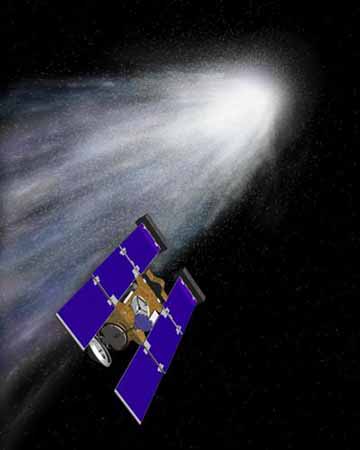
NASA scientists have discovered glycine, a fundamental building block of life, in samples of comet Wild 2 returned by NASA's Stardust spacecraft. "Glycine is an amino acid used by living organisms to make proteins, and this is the first time an amino acid has been found in a comet," said Dr. Jamie Elsila of NASA's Goddard Space Flight Center. Our discovery supports the theory that some of life's ingredients formed in space and were delivered to Earth long ago by meteorite and comet impacts.
Did Life Begin In Space? New Evidence From Comets Science Daily - August 14, 2007
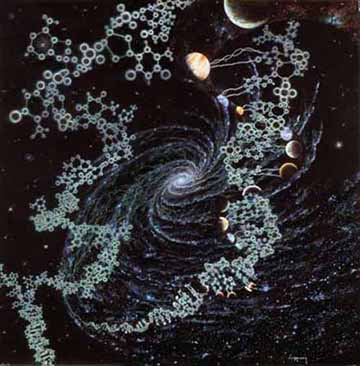
Professor Chandra Wickramasinghe and colleagues at the University's Centre for Astrobiology have long argued the case for panspermia - the theory that life began inside comets and then spread to habitable planets across the galaxy. A recent BBC Horizon documentary traced the development of the theory. Now the team claims that findings from space probes sent to investigate passing comets reveal how the first organisms could have formed. The 2005 Deep Impact mission to Comet Tempel 1 discovered a mixture of organic and clay particles inside the comet. One theory for the origins of life proposes that clay particles acted as a catalyst, converting simple organic molecules into more complex structures. The 2004 Stardust Mission to Comet Wild 2 found a range of complex hydrocarbon molecules - potential building blocks for life.
Stardust capsule returns to Earth BBC - January 15, 2006

A capsule containing comet particles and interstellar dust has landed on Earth after a seven-year space mission. The Stardust probe released the capsule as it flew back to Earth after a 4.6-billion-km (2.8-billion-mile) trip. The US-built capsule plunged through the atmosphere and touched down in the Utah desert at 0312 (1012 GMT). Scientists believe the first cometary dust samples ever returned to Earth will shed light on the origins of the Solar System. Mission controllers at the US space agency's (Nasa) Jet Propulsion Laboratory in Pasadena, California, clapped and cheered as the capsule began its plunge to Earth. Four hours after leaving the probe, the capsule entered the Earth's atmosphere 125km (410,000ft) over the Pacific Ocean.
As late as 2002, there is conflict on how much ice is in a comet. NASA's Deep Space 1 team, working at NASA's Jet Propulsion Lab, obtained high-resolution images of the surface of comet Borrelly. They announced that comet Borrelly exhibits distinct jets, yet has a hot, dry surface. The assumption that comets contain water and other ices led Dr. Laurence Soderblom of the U.S. Geological Survey to say, "The spectrum suggests that the surface is hot and dry. It is surprising that we saw no traces of water ice." However, he goes on to suggest that the ice is probably hidden below the crust as "either the surface has been dried out by solar heating and maturation or perhaps the very dark soot-like material that covers Borrelly's surface masks any trace of surface ice".
The recent Deep Impact probe has also yielded results suggesting that the majority of a comet's water ice is below the surface, and that these reservoirs feed the jets of vaporised water that form the coma of Tempel 1.
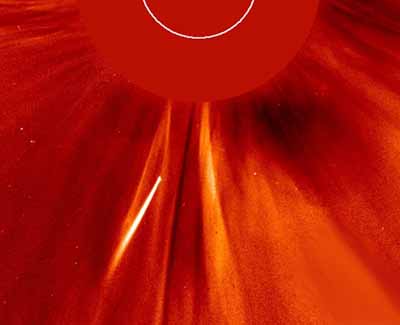
A Sungrazing comet is a comet that passes extremely close to the Sun at perihelion, sometimes within a few thousand kilometres of the Sun's surface. While small sungrazers can be completely evaporated during such a close approach to the Sun, larger sungrazers can survive many perihelion passages. However, the strong tidal forces they experience often lead to their fragmentation.
About 90% of the sungrazers observed with SOHO are member of the Kreutz group, which all originate from one giant comet that broke up into many smaller comets during its first passage through the inner solar system, The other 10% contains some sporadic sungrazers, but four other related groups of comets have been identified among them: the Kracht, Kracht 2a, Marsden and Meyer groups. The Marsden and Kracht groups both appear to be related to Comet 96P/Machholz, which is also the parent of two meteor streams, the Quadrantids and the Arietids.
Of the thousands of known comets, some are very unusual. Comet Encke orbits from outside the main asteroid belt to inside the orbit of Mercury while Comet 29P/Schwassmann-Wachmann orbits in a nearly circular orbit entirely between Jupiter and Saturn. 2060 Chiron, whose unstable orbit keeps it between Saturn and Uranus, was originally classified as an asteroid until a faint coma was noticed. Similarly, Comet Shoemaker-Levy 2 was originally designated asteroid 1990 UL3. Some near-earth asteroids are thought to be extinct nuclei of comets which no longer experience outgassing.
Some comets have been observed to break up during their perihelion passage, including great comets West and Comet Ikeya-Seki. Comet Biela was one significant example, breaking into two during its 1846 perihelion passage. The two comets were seen separately in 1852, but never again after that. Instead, spectacular meteor showers were seen in 1872 and 1885 when the comet should have been visible. A lesser meteor shower, the Andromedids, occurs annually in November, and is caused by the Earth crossing Biela's orbit.
Another very significant cometary disruption was that of Comet Shoemaker-Levy 9, which was discovered in 1993. At the time of its discovery, the comet was in orbit around Jupiter, having been captured by the planet during a very close approach in 1992. This close approach had already broken the comet into hundreds of pieces, and over a period of 6 days in July 1994, these pieces slammed into Jupiter's atmosphere - the first time astronomers had observed a collision between two objects in the solar system. It has also been suggested that the object likely to have been responsible for the Tunguska Event in 1908 was a fragment of Comet Encke.
Massive eruption from icy volcanic comet detected in solar system Live Science - December 2, 2022
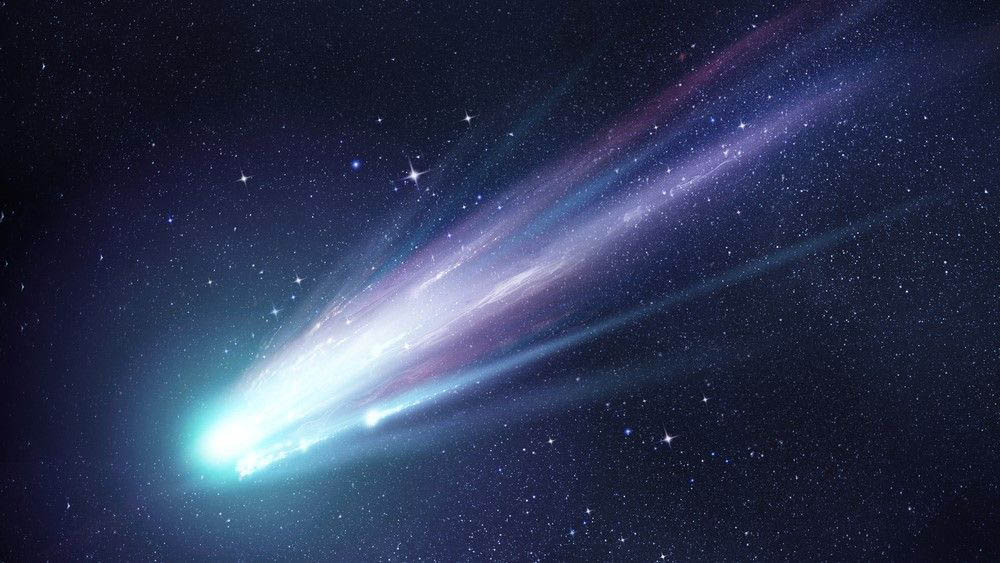
A bizarre, volcanic comet has violently erupted, spewing out more than 1 million tons of gas, ice and the "potential building blocks of life" into the solar system. The volatile comet, known as 29P/Schwassmann-Wachmann (29P), is around 37 miles (60 kilometers) wide and takes around 14.9 years to orbit the sun. 29P is believed to be the most volcanically active comet in the solar system. It is one of around 100 comets, known as "centaurs," that have been pushed from the Kuiper Belt a ring of icy comets that lurk beyond Neptune - into a closer orbit around the sun between those of Jupiter and Neptune, according to NASA (opens in new tab).
Weird Space Rock Confirmed as Super-Rare Hybrid of Comet And Asteroid Science Alert - October 5, 2021
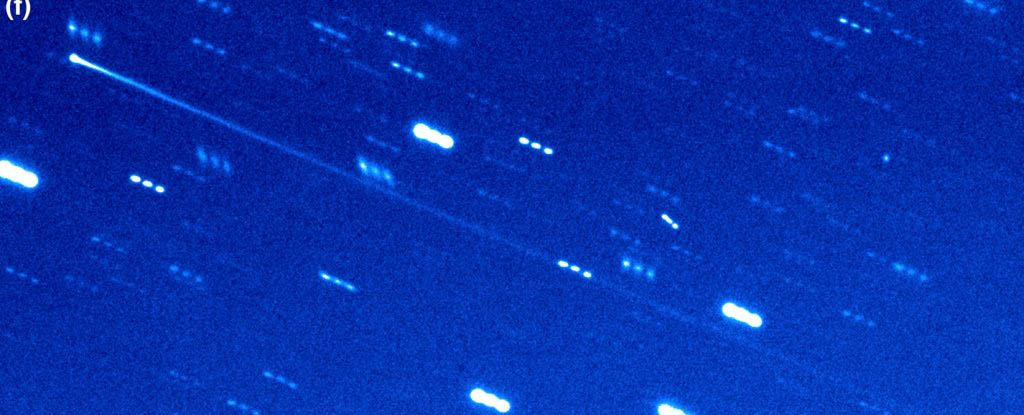
Comets and asteroids are both types of rocks that hang out in space, but their differences are pretty pronounced. Comets typically hail from the outer Solar System and have long, elliptical orbits. They're filled with ices that start to sublimate when the comet gets close to the Sun, generating a dusty, misty atmosphere (called a coma) and the famous cometary tails.
Gigantic Comet Approaching From Outer Solar System May Be The Largest Ever Seen Science Alert - September 30, 2021
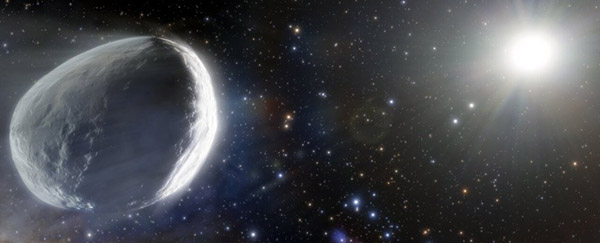
A comet so huge it was initially mistaken for a dwarf planet is on an inward-bound trajectory from the outer Solar System. There's no reason to worry Š C/2014 UN271 (Bernardinelli-Bernstein), as the comet is called, will approach no closer to the Sun than just outside the orbit of Saturn. But its large size and relative closeness will afford a rare opportunity to study a pristine object from the Oort Cloud, and find new information about the formation of the Solar System.
Comet Ingredients Swallowed by an Asteroid, Found Sealed Inside a Meteorite Live Science - April 15, 2019
The raw materials from a comet have been found sealed inside a pristine, primitive meteorite. The meteorite was found in the LaPaz icefield of Antarctica and has weathered very little since the time it crashed to Earth. According to a new study published today (April 15) in the journal Nature Astronomy, researchers found that this sample of space rock contains something strange: bits of the building blocks of a comet that became trapped in the meteorite's parent asteroid just 3 million years after the solar system formed. Because this sample of cometary building block material was swallowed by an asteroid and preserved inside this meteorite, it was protected from the ravages of entering Earth's atmosphere.
Comet impacts cook up 'soup of life' BBC - August 19, 2015
New results show how collisions between comets and planets can make molecules that are the essential building blocks of life. This suggests that the chemistry needed to gather the molecular ingredients for life could be more common than previously recognized. Earth scientists from Japan carried out experiments to mimic comet impacts that occurred on early Earth. They found chemical reactions to make the primordial "soup for life" can occur anywhere that comets collide.
Philae comet lander wakes up BBC - June 14, 2015
Philae, the first spacecraft to land on a comet, was dropped on to the surface of Comet 67P by its mothership, Rosetta, last November. It worked for 60 hours before its solar-powered battery ran flat.
First ever evidence of a comet striking Earth PhysOrg - October 8, 2013
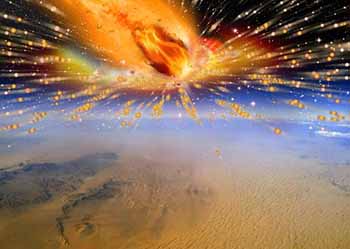
The first ever evidence of a comet entering Earth's atmosphere and exploding, raining down a shock wave of fire which obliterated every life form in its path, has been discovered by a team of South African scientists and international collaborators. The discovery has not only provided the first definitive proof of a comet striking Earth, millions of years ago, but it could also help us to unlock, in the future, the secrets of the formation of our solar system.
Comet's water 'like that of Earth's oceans' BBC - October 6, 2011
Comet Hartley 2 contains water more like that found on Earth than all the comets we know about, researchers say. A study using the Herschel space telescope aimed to measure the fraction of deuterium, a rare type of hydrogen, present in the comet's water. Like our oceans, it had half the amount of deuterium seen from other comets.
Probe sweeps past 'space peanut' BBC - November 4, 2010
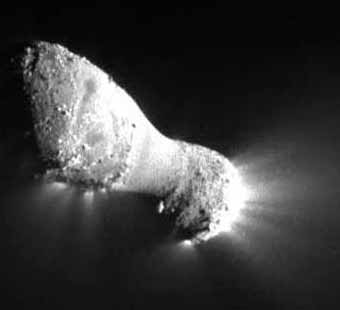
Nasa's Deep Impact probe has flown by Comet Hartley 2. The first pictures revealed a roughly 1.5km-long, peanut-shaped object with jets of gas streaming from its surface. The pass, which occurred about 23 million km from Earth, was only the fifth time a spacecraft had made a close approach to a comet.
Comet Killed Ice Age Beasts Live Science - July 20, 2009
Space rocks that slammed into the glaciers of eastern Canada some 12,900 years ago likely helped wipe out mega-animals like woolly mammoths and possibly the continent's first human inhabitants called the Clovis people, according to a new study that adds to evidence that a trio of factors were involved. The new evidence comes from recently discovered nano-sized diamonds, which researchers say are the strongest clues to date for an argument that could explain the region's die-off during the late Pleistocene epoch. Scientists have long debated what caused this catastrophic extinction event, sending more than three-fourths of North America's large Ice Age animals and the Clovis people to their graves. (The Clovis people were a Stone Age group that had only recently immigrated to the continent.)
California's Channel Islands hold evidence of Clovis-age comets PhysOrg - July 20, 2009
A 17-member team has found what may be the smoking gun of a much-debated proposal that a cosmic impact about 12,900 years ago ripped through North America and drove multiple species into extinction. Colleagues from nine institutions and three private research companies report the presence of shock-synthesized hexagonal diamonds in 12,900-year-old sediments on the Northern Channel Islands off the southern California coast. These tiny diamonds and diamond clusters were buried deeply below four meters of sediment. They date to the end of Clovis - a Paleoindian culture long thought to be North America's first human inhabitants. The nano-sized diamonds were pulled from Arlington Canyon on the island of Santa Rosa that had once been joined with three other Northern Channel Islands in a landmass known as Santarosae. The diamonds were found in association with soot, which forms in extremely hot fires, and they suggest associated regional wildfires, based on nearby environmental records. Such soot and diamonds are rare in the geological record. They were found in sediment dating to massive asteroid impacts 65 million years ago in a layer widely known as the K-T Boundary. The thin layer of iridium-and-quartz-rich sediment dates to the transition of the Cretaceous and Tertiary periods, which mark the end of the Mesozoic Era and the beginning of the Cenozoic Era.
Two Tails of Comet Lulin NASA - February 25, 2009
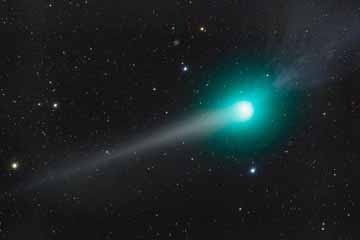
Yesterday, Comet Lulin passed its closest to Earth, so that the comet will remain near its brightest over the next few days. The comet is currently almost 180 degrees around from the Sun and so visible nearly all night long, but will appear to move on the sky about 10 full moons a night. In this image, Comet Lulin was captured in spectacular form two nights ago from New Mexico, USA. The central coma of the comet is appearing quite green, a color likely indicating glowing molecular carbon gasses. Bright stars and a distant spiral galaxy are clearly visible in the image background. The yellow dust tail, reflecting sunlight, is visible sprawling to the coma's left trailing behind the comet, while the textured bluish-glowing ion tail is visible to the coma's right, pointing away from the Sun. Over the past few weeks, from the current vantage point of Earth, these two tails appeared to point in opposite directions. Comet Lulin is expected to slowly fade over the next few weeks.
Six North American Sites Hold 12,900-year-old Nanodiamond-rich Soil Science Daily - January 2, 2009
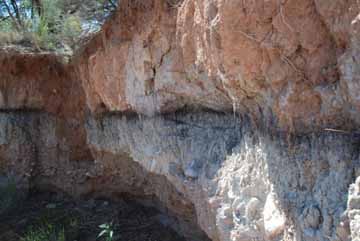
Abundant tiny particles of diamond dust exist in sediments dating to 12,900 years ago at six North American sites, adding strong evidence for Earth's impact with a rare swarm of carbon-and-water-rich comets or carbonaceous chondrites, reports a nine-member scientific team. These nanodiamonds, which are produced under high-temperature, high-pressure conditions created by cosmic impacts and have been found in meteorites, are concentrated in similarly aged sediments at Murray Springs, Ariz., Bull Creek, Okla., Gainey, Mich., and Topper, S.C., as well as Lake Hind, Manitoba, and Chobot, Alberta, in Canada. Nanodiamonds can be produced on Earth, but only through high-explosive detonations or chemical vaporization.
NASA Finds New Type Of Comet Dust Mineral Science Daily - June 17, 2008
NASA researchers and scientists from the United States, Germany and Japan have found a new mineral in material that likely came from a comet. The mineral, a manganese silicide named Brownleeite, was discovered within an interplanetary dust particle, or IDP, that appears to have originated from comet 26P/Grigg-Skjellerup. The comet originally was discovered in 1902 and reappears every 5 years. The team that made the discovery is headed by Keiko Nakamura-Messenger, a space scientist at NASA's Johnson Space Center in Houston. The mineral, a manganese silicide named Brownleeite, was discovered within an interplanetary dust particle, or IDP, that appears to have originated from comet 26P/Grigg-Skjellerup. The comet originally was discovered in 1902 and reappears every 5 years. The team that made the discovery is headed by Keiko Nakamura-Messenger, a space scientist at NASA's Johnson Space Center in Houston.
2007: A Year of Spectacular Comets NASA - December 31, 2007
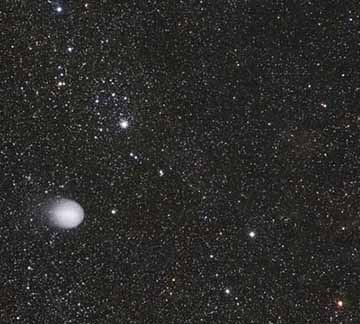
Two spectacular comets graced Earth's skies during 2007. Both comets became bright enough to be seen by the unaided eye of the casual sky enthusiast. Early in 2007, Comet McNaught grew brighter than any comet in 40 years, displaying a beautiful dust tail that flowed across the sky. Comet McNaught (c/2006 P1) became known as the Great Comet of 2007, sported unusual striations in its expansive dust tail, and showed unexpectedly complex chemistry in its ion tail. Toward the year's end, normally docile and faint Comet Holmes brightened suddenly and unexpectedly to naked eye visibility. Remarkably, Comet 17P/Holmes stayed bright for weeks even though it lies beyond the orbit of Mars. No distant comet in recent history has remained so bright for so long. In this view, a white Comet Holmes was photographed in early December posing with the Heart and Soul Nebulas.